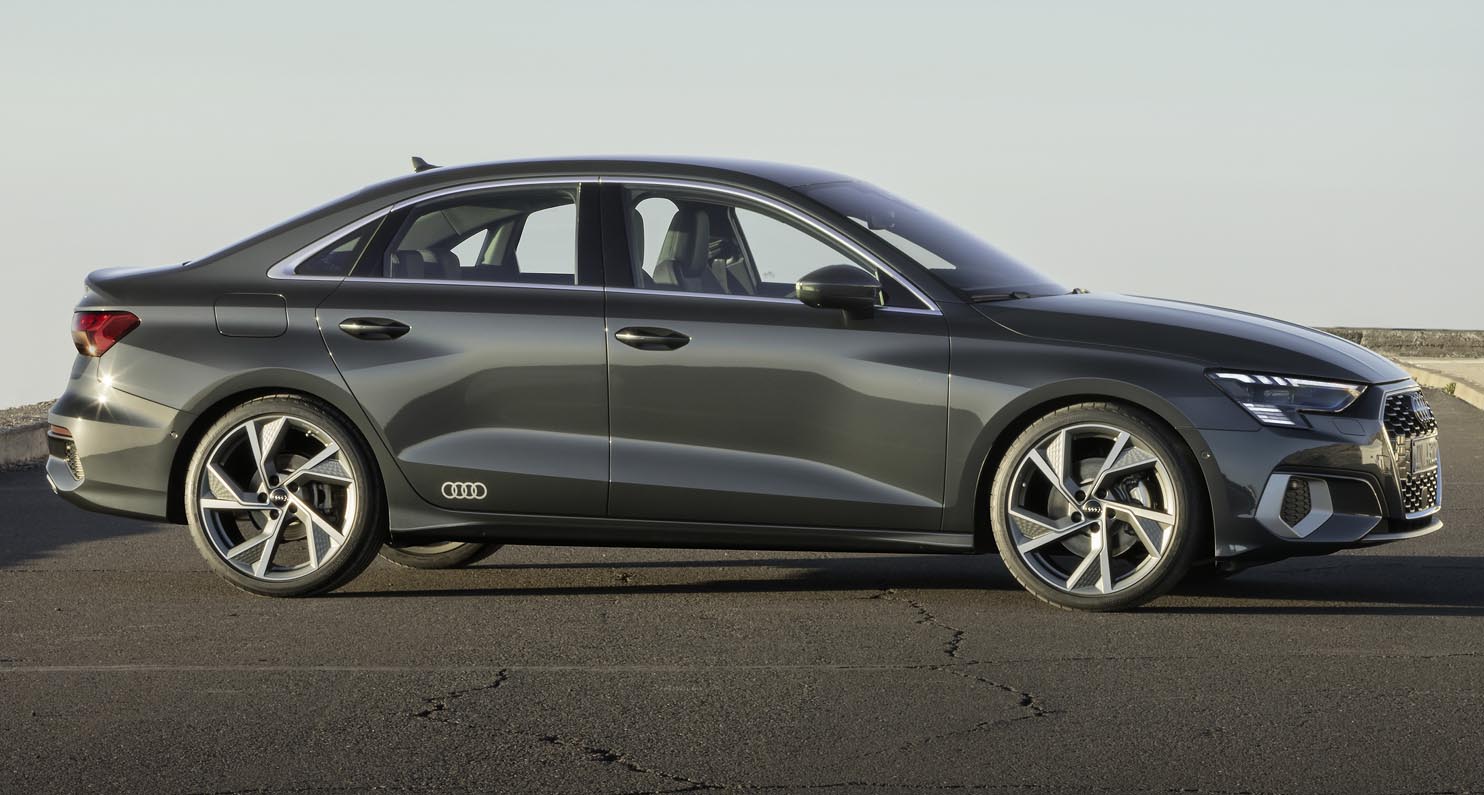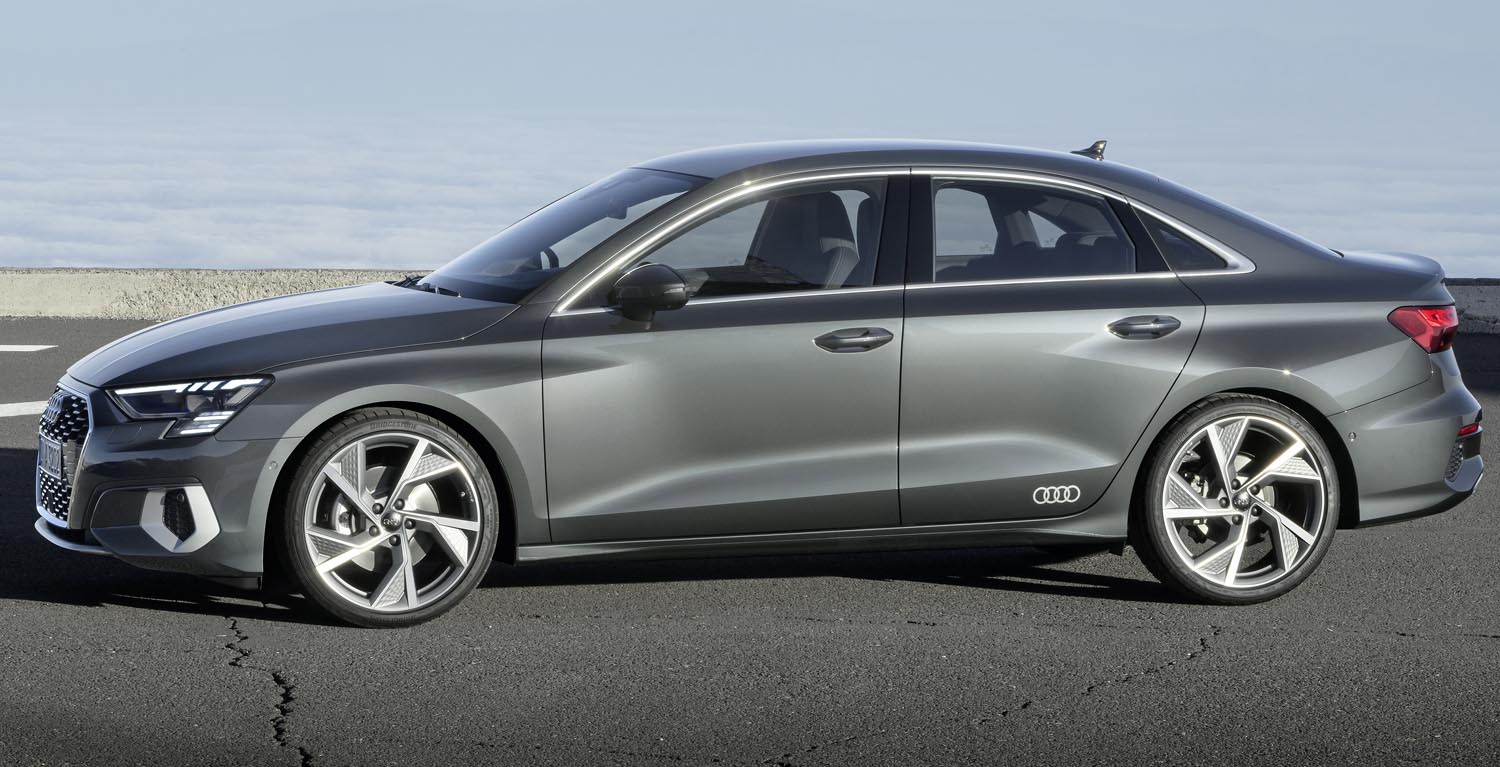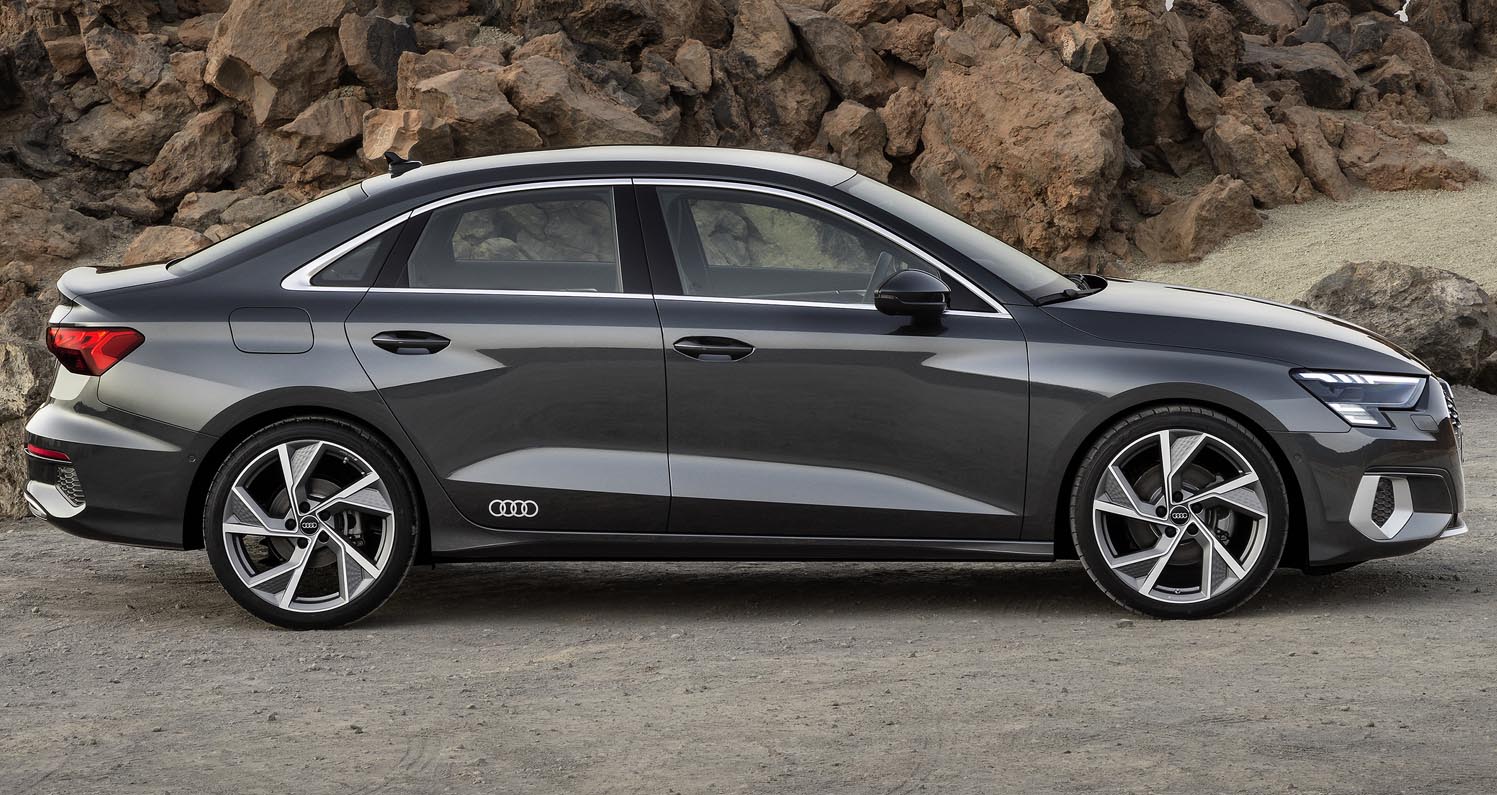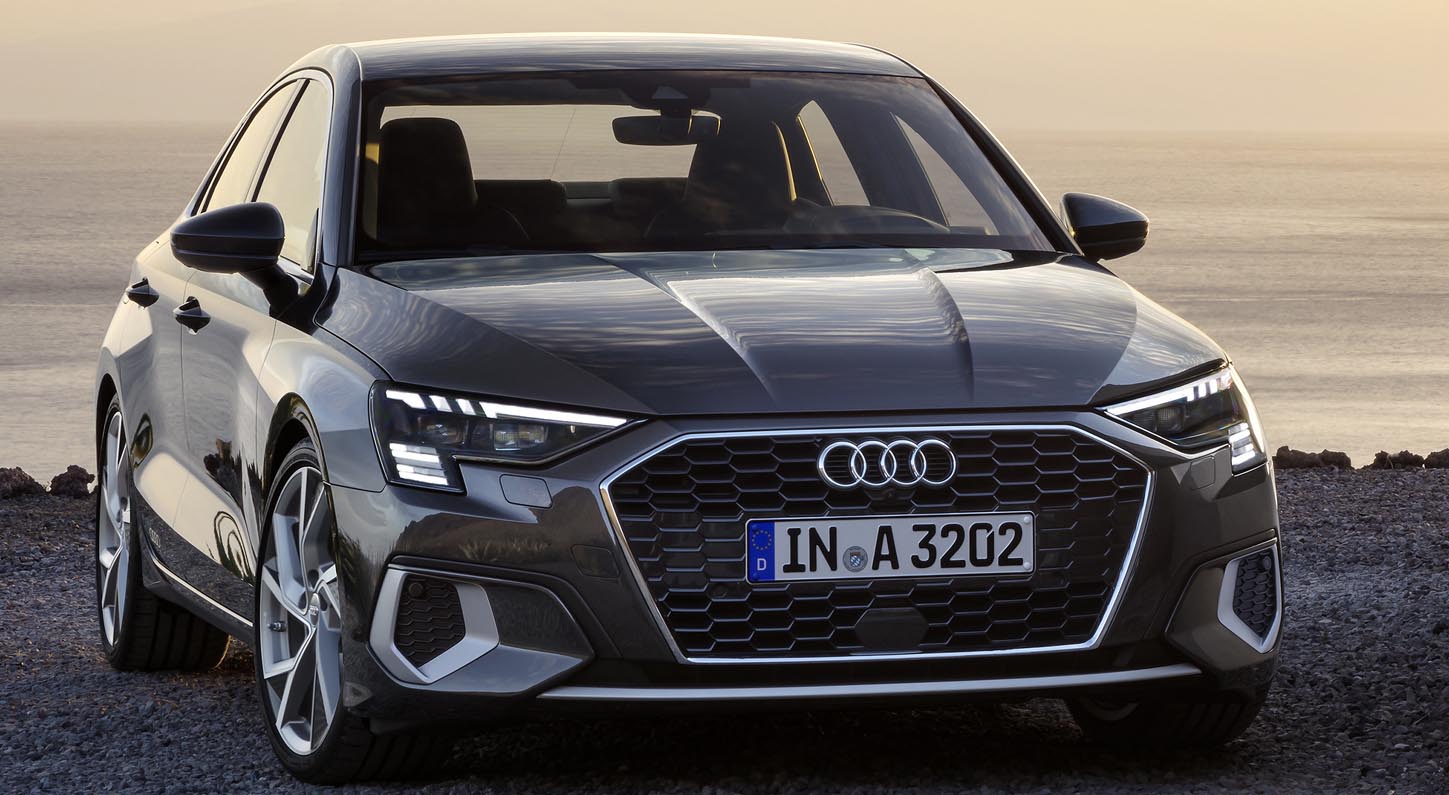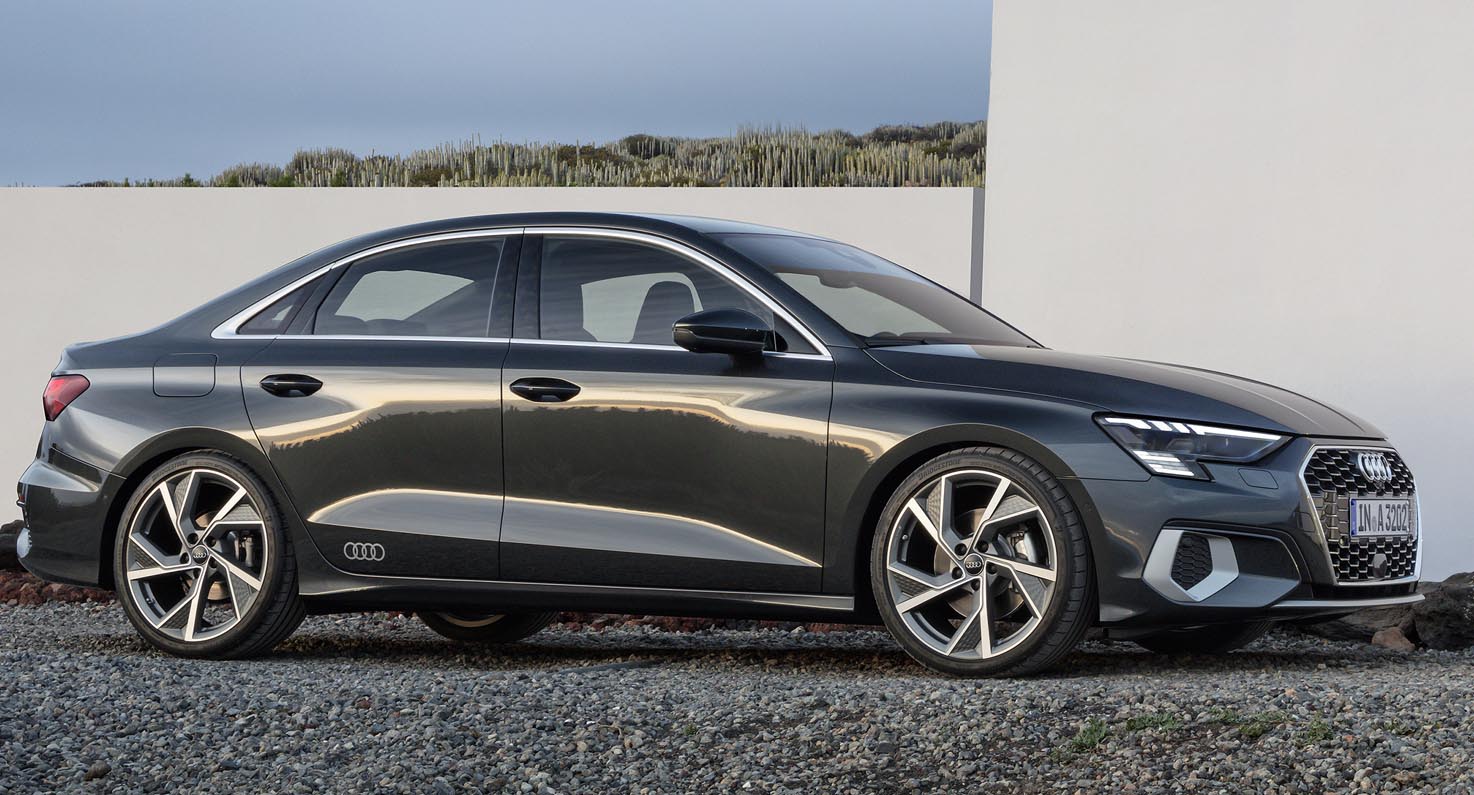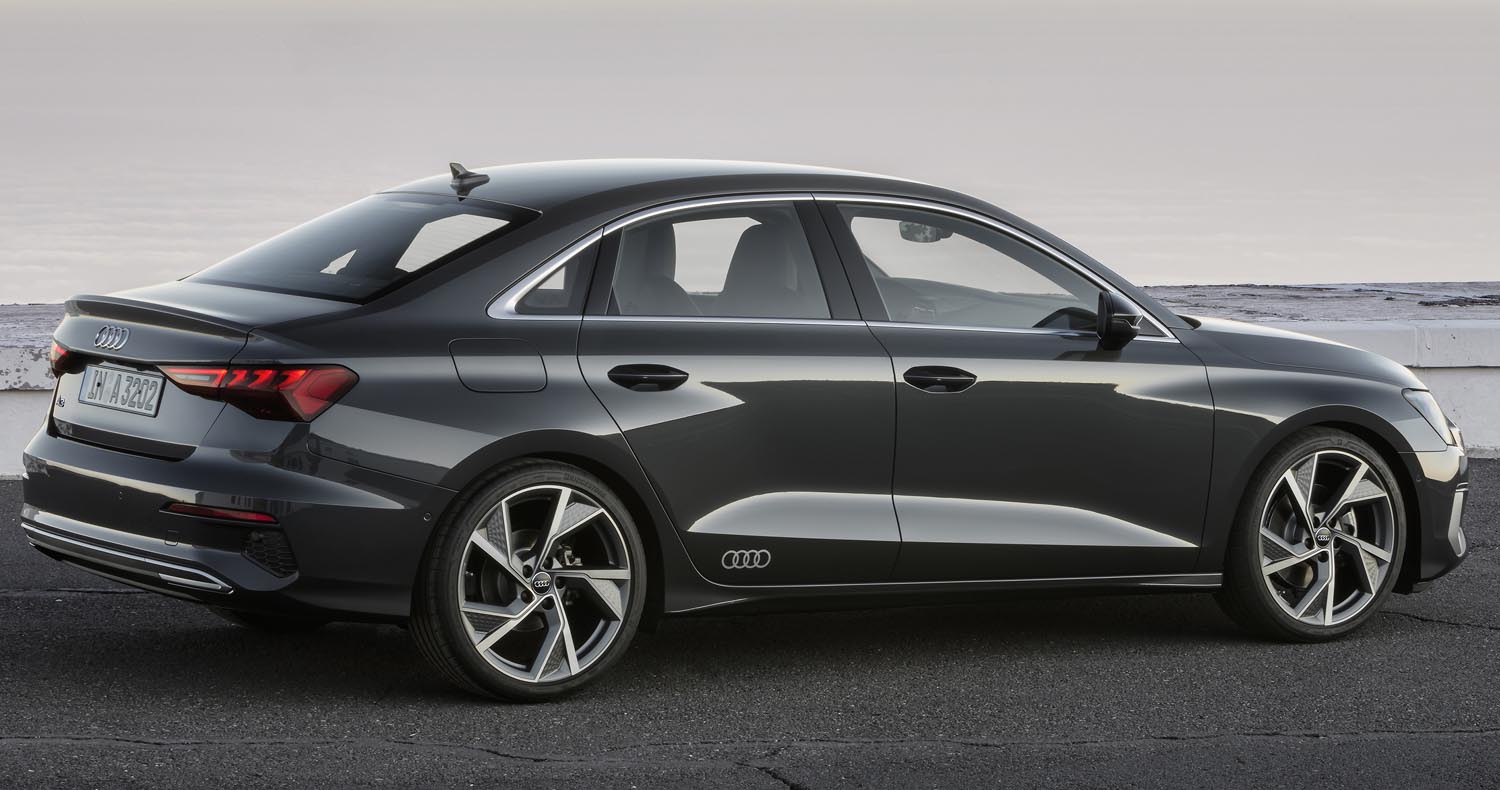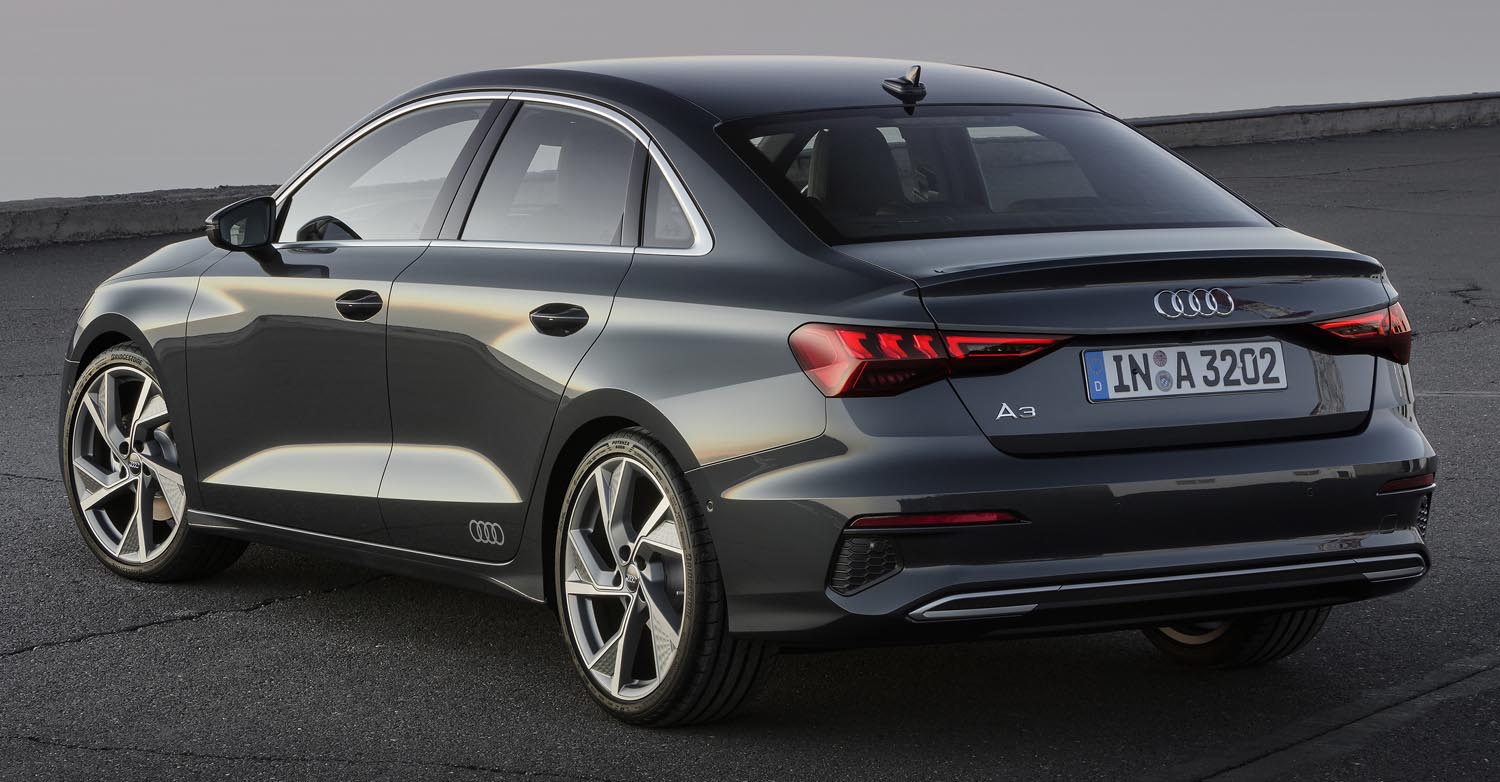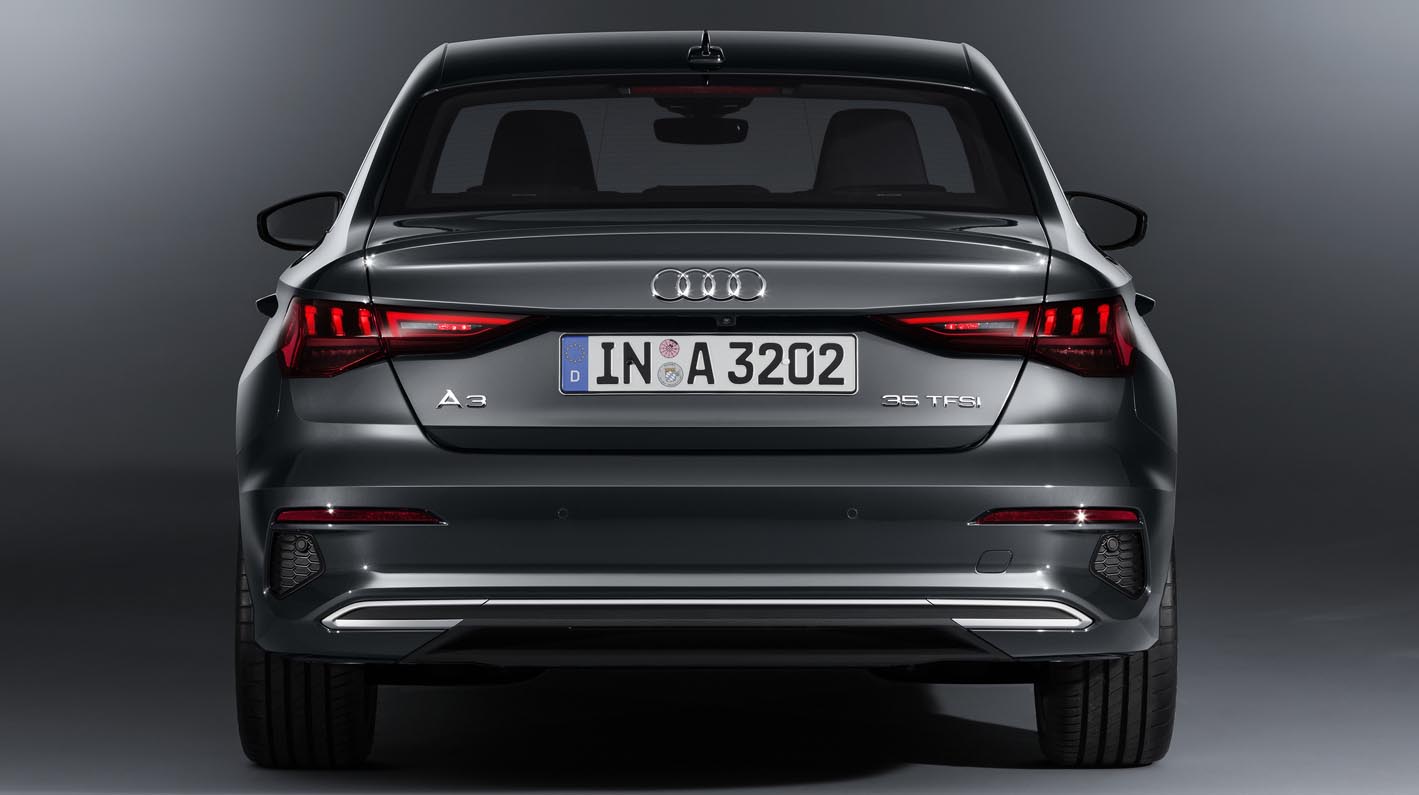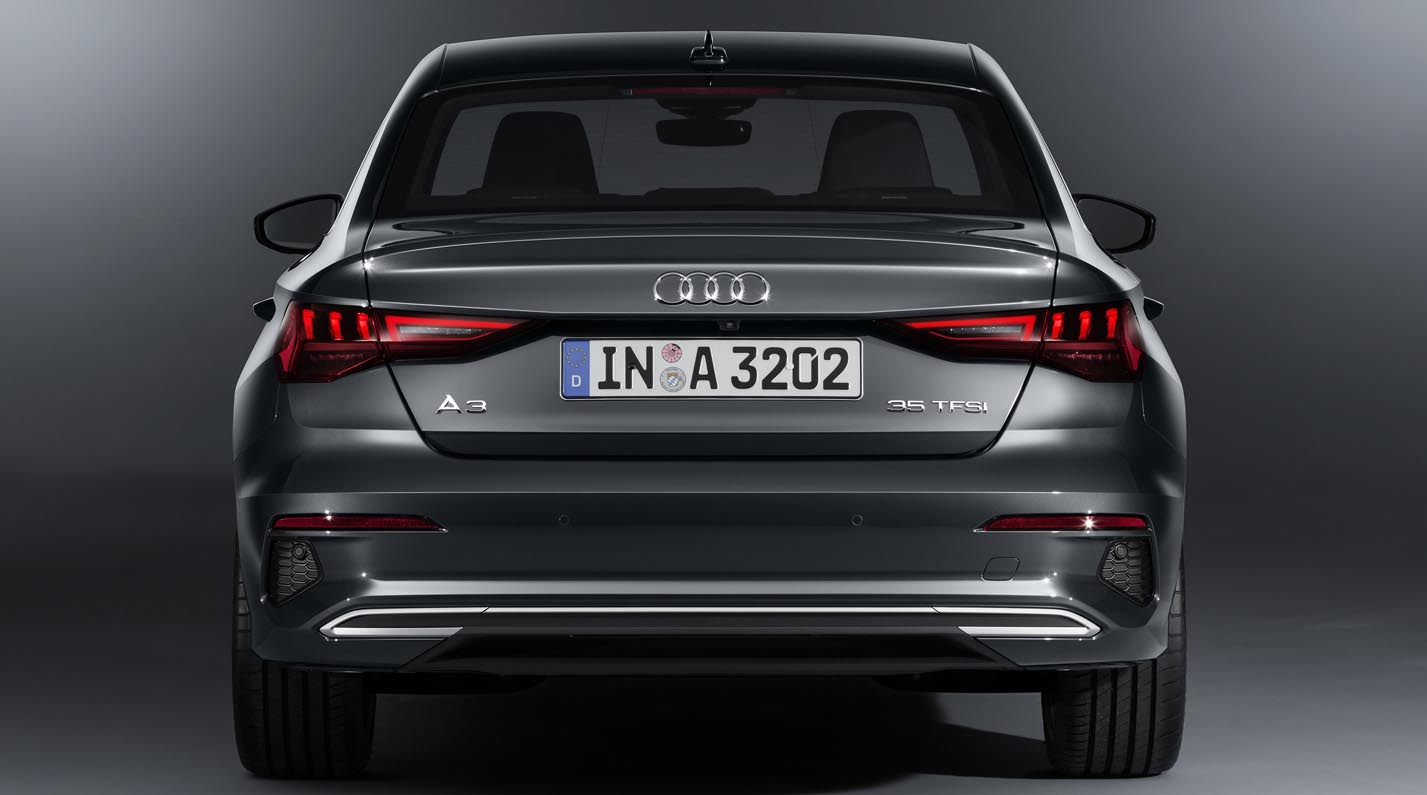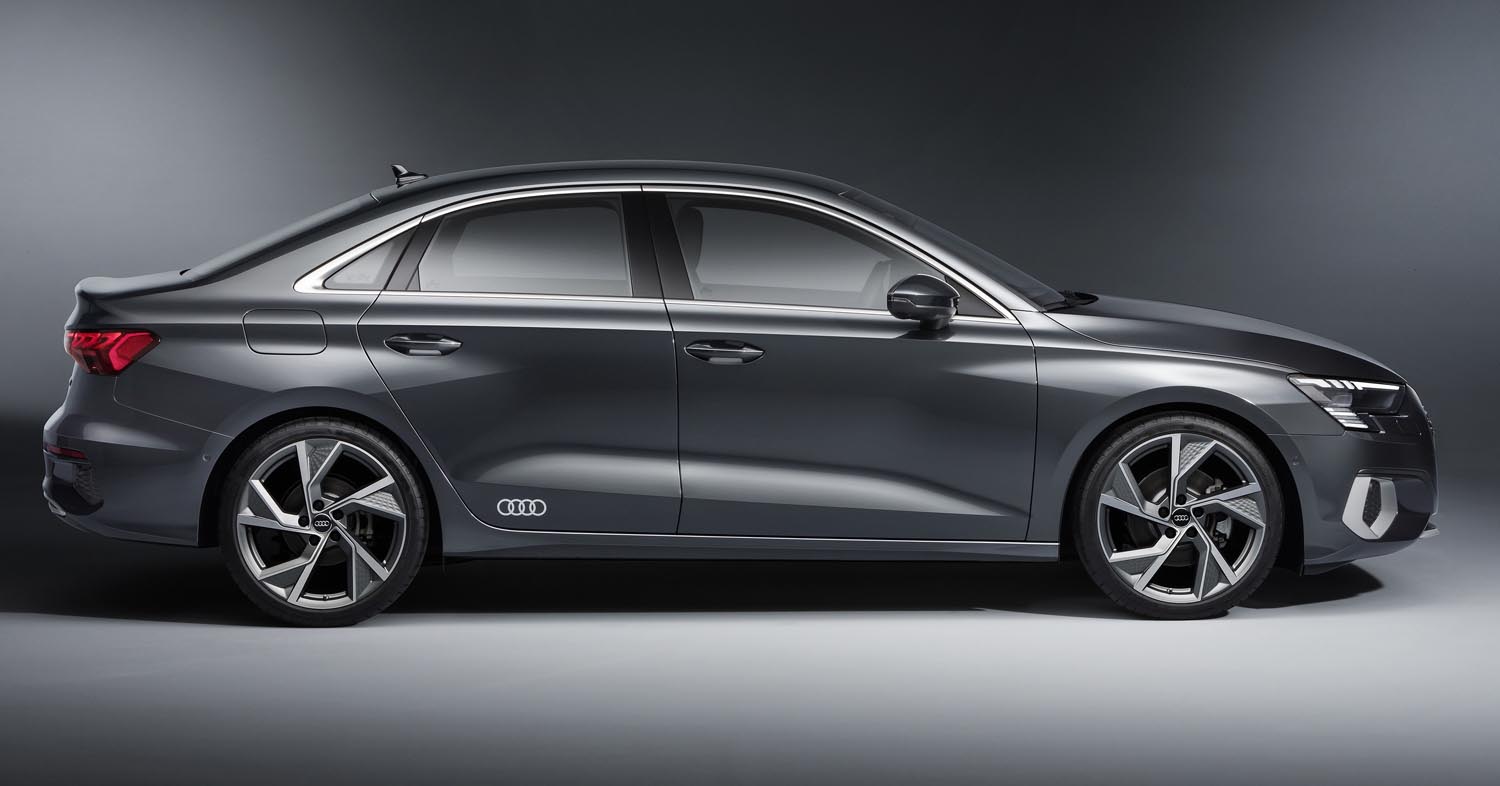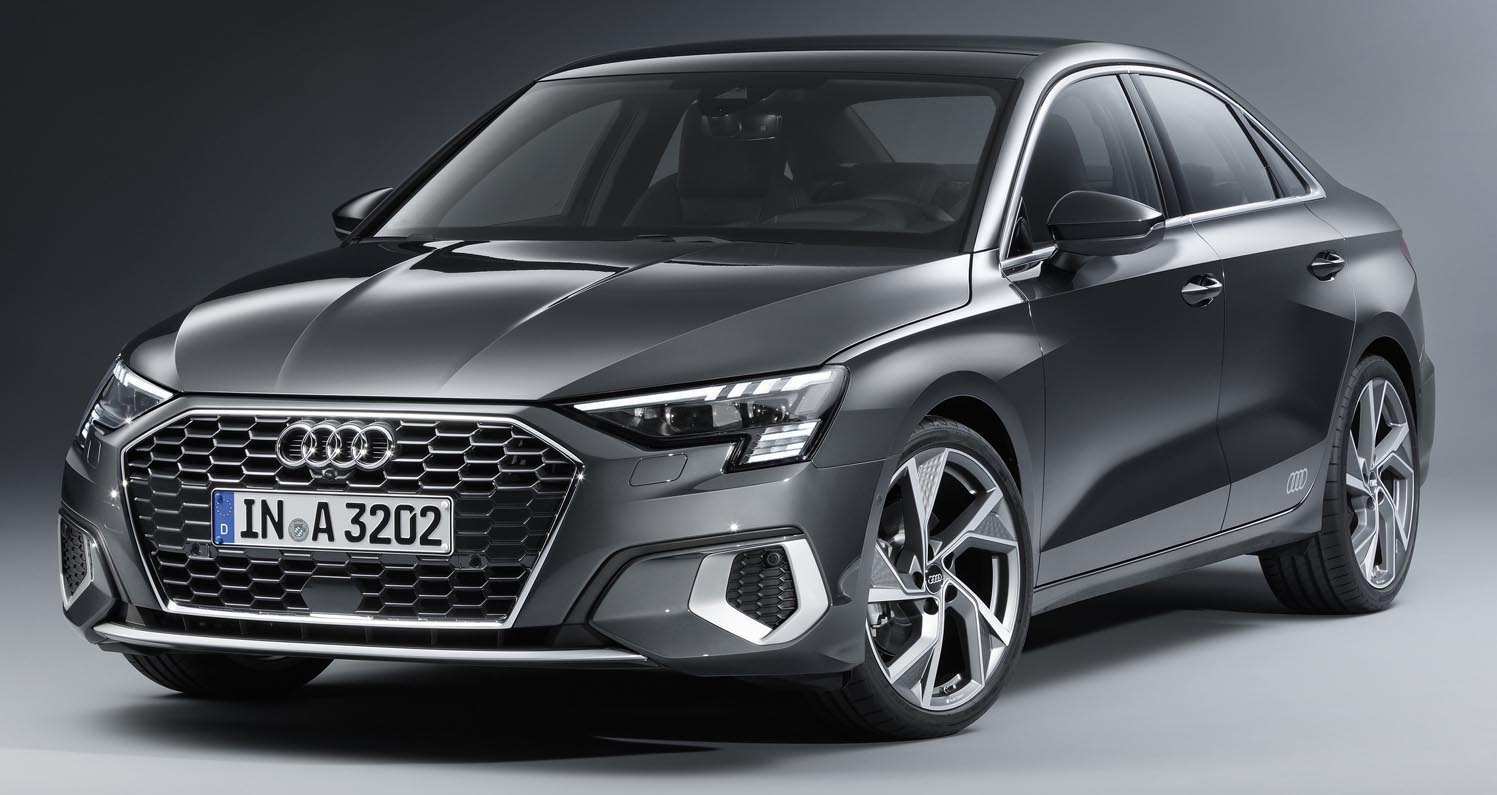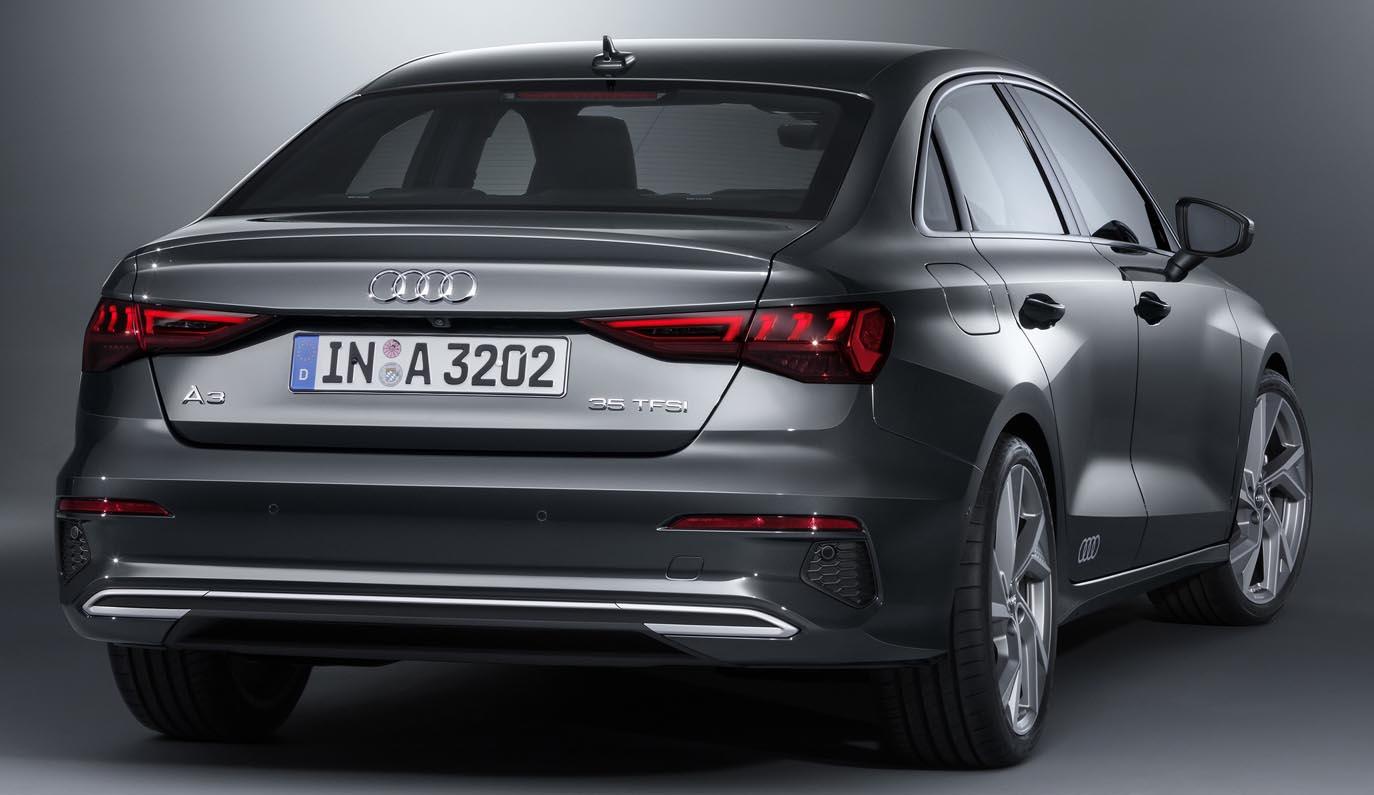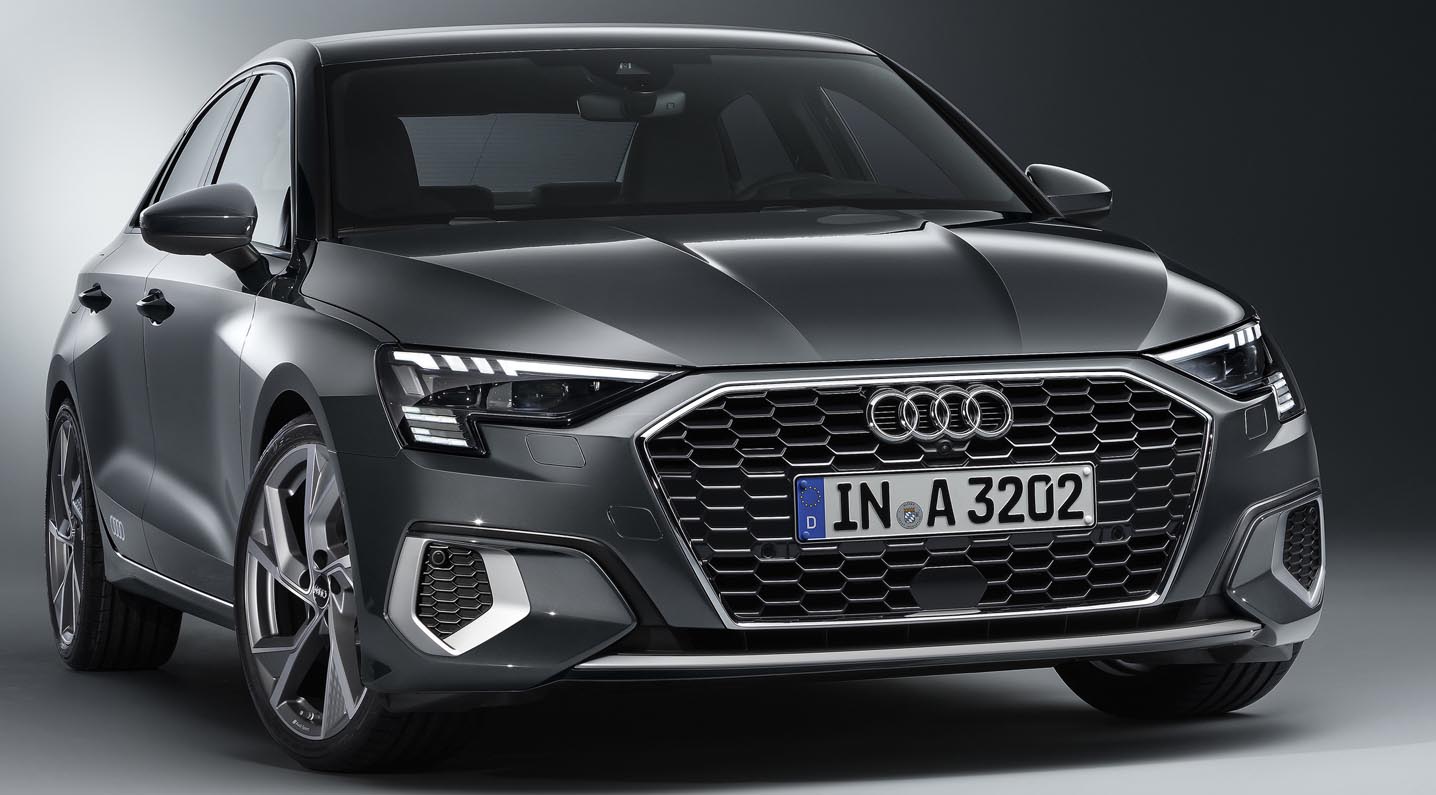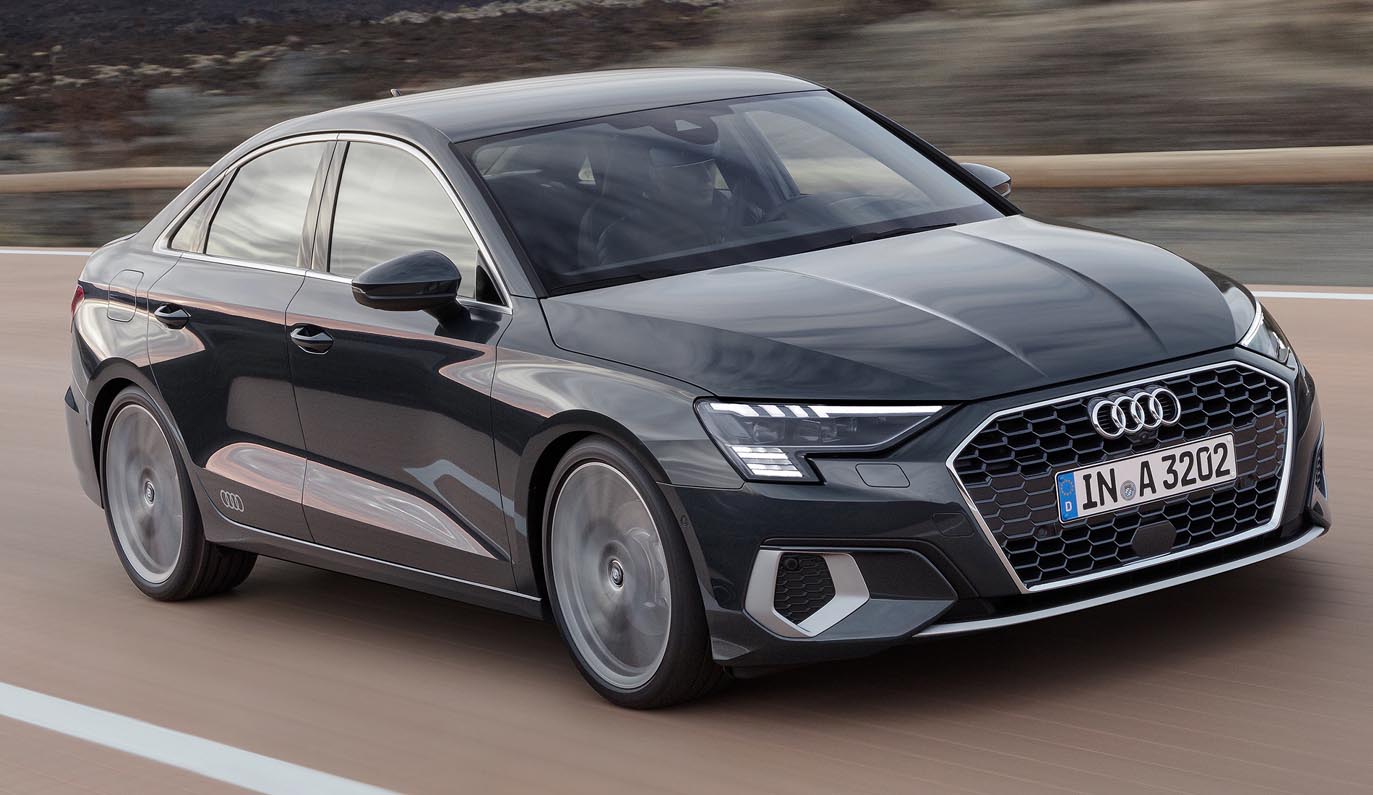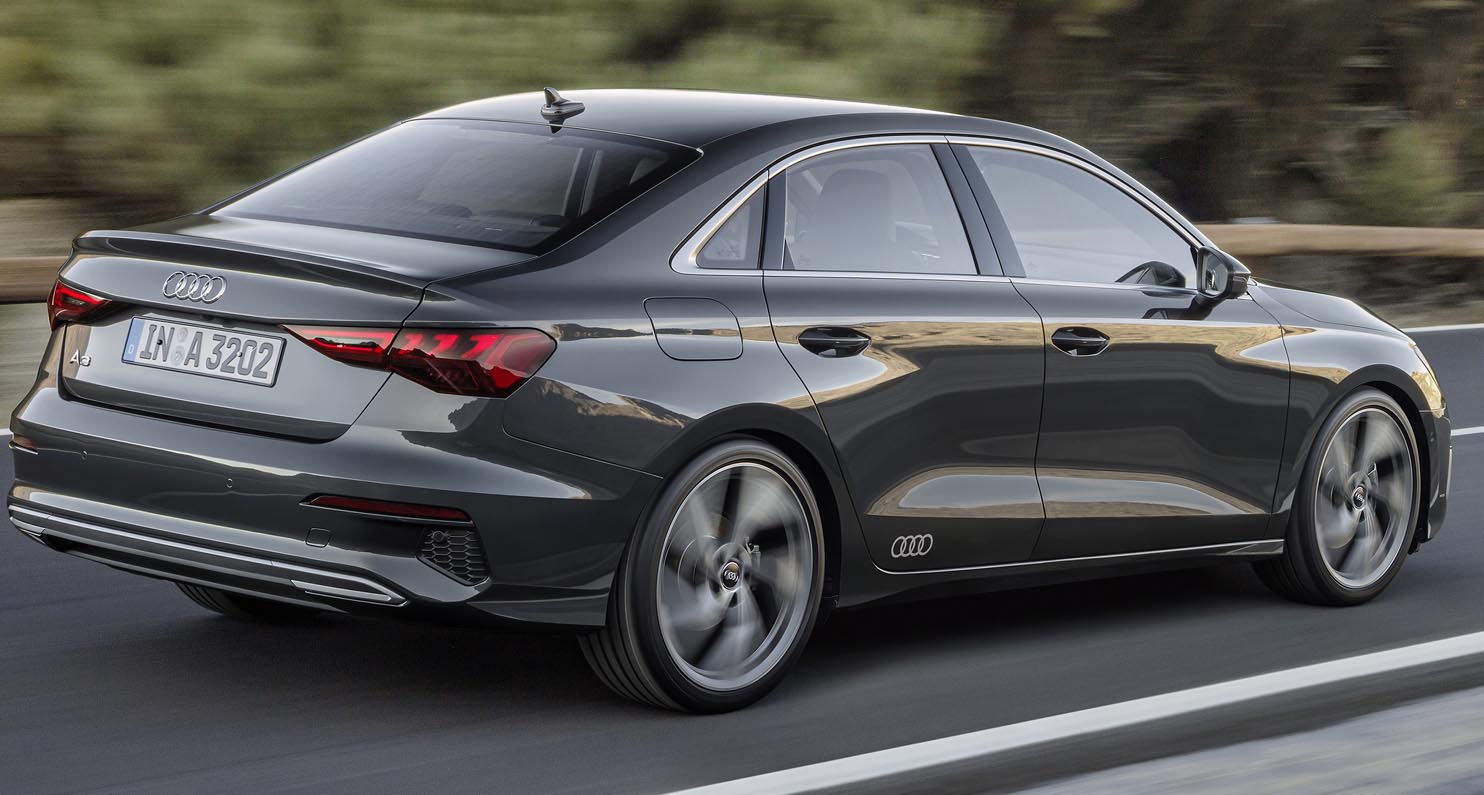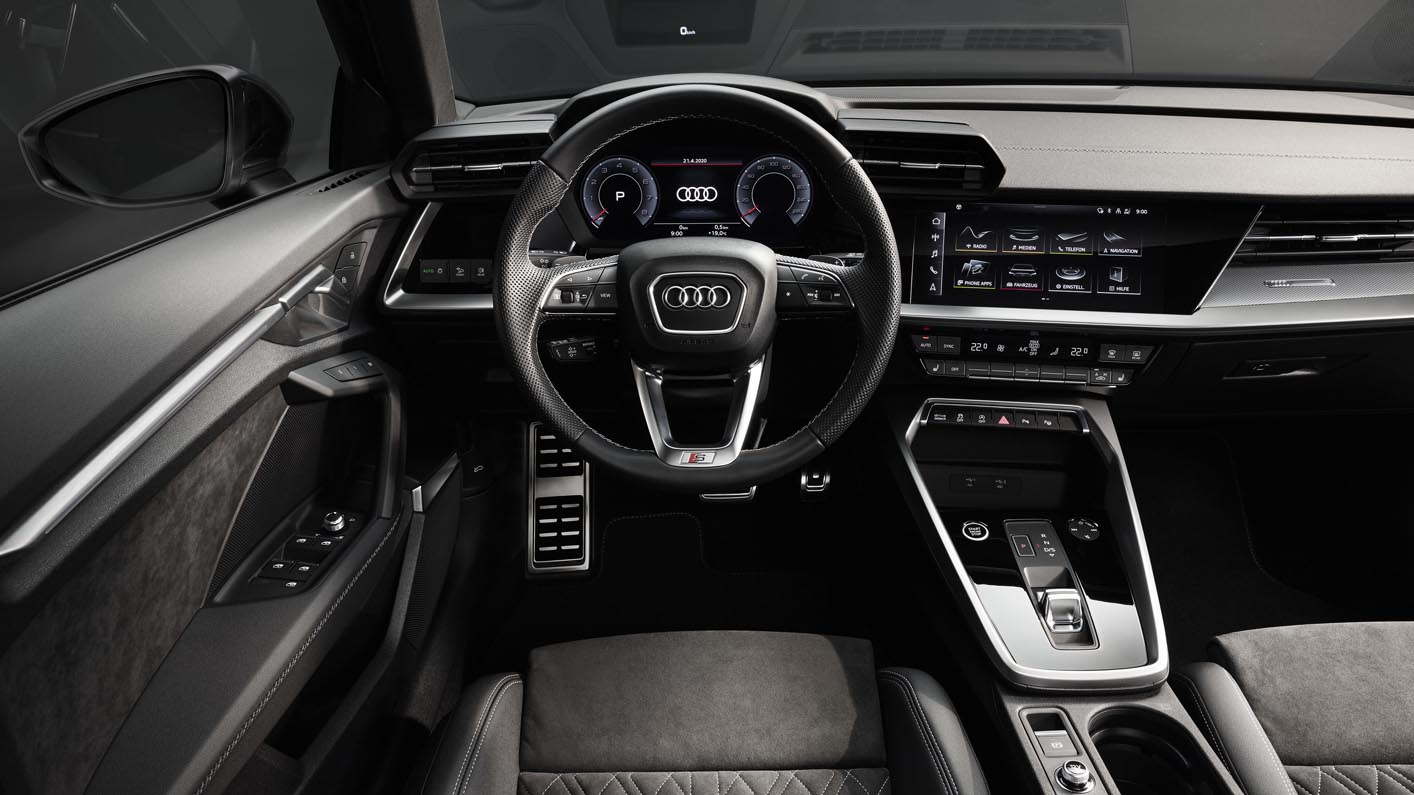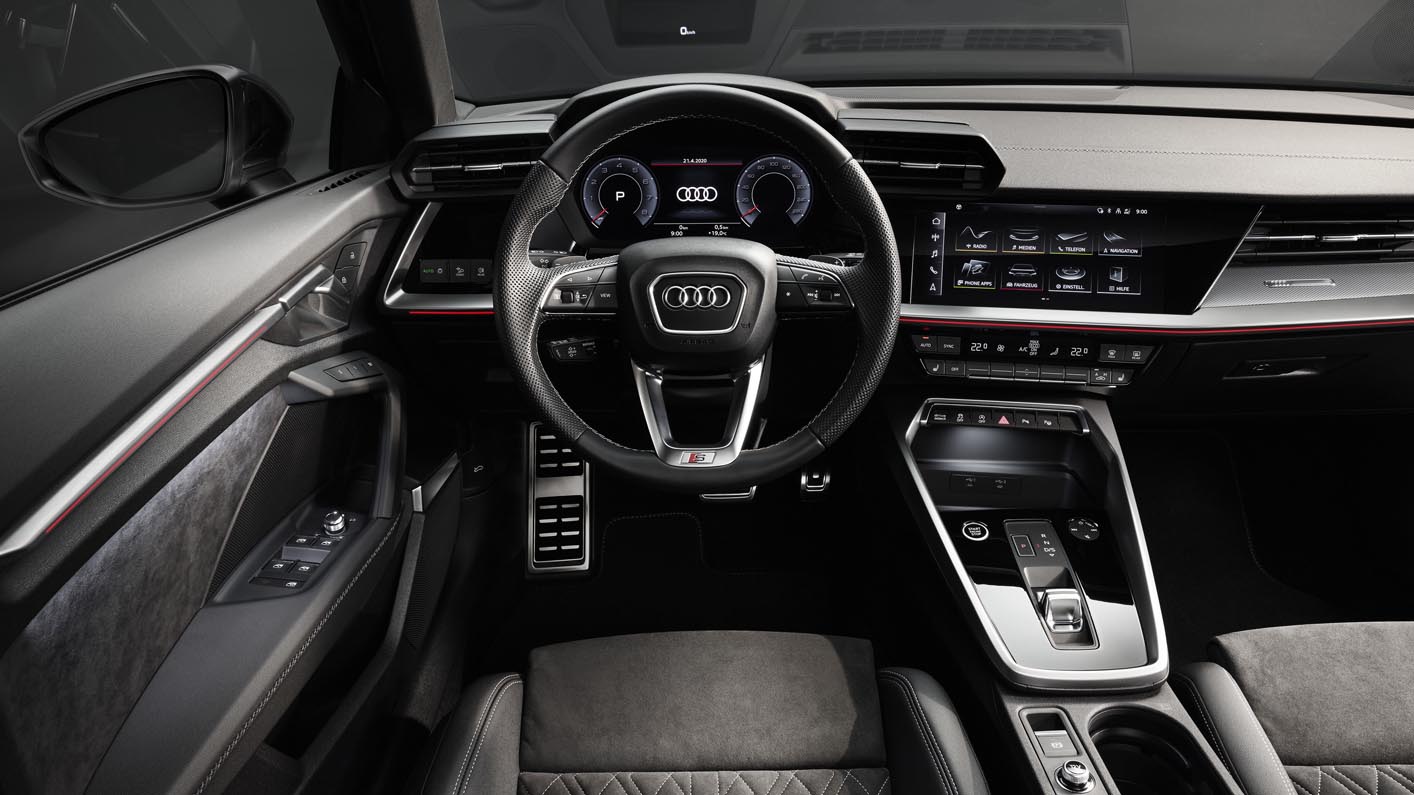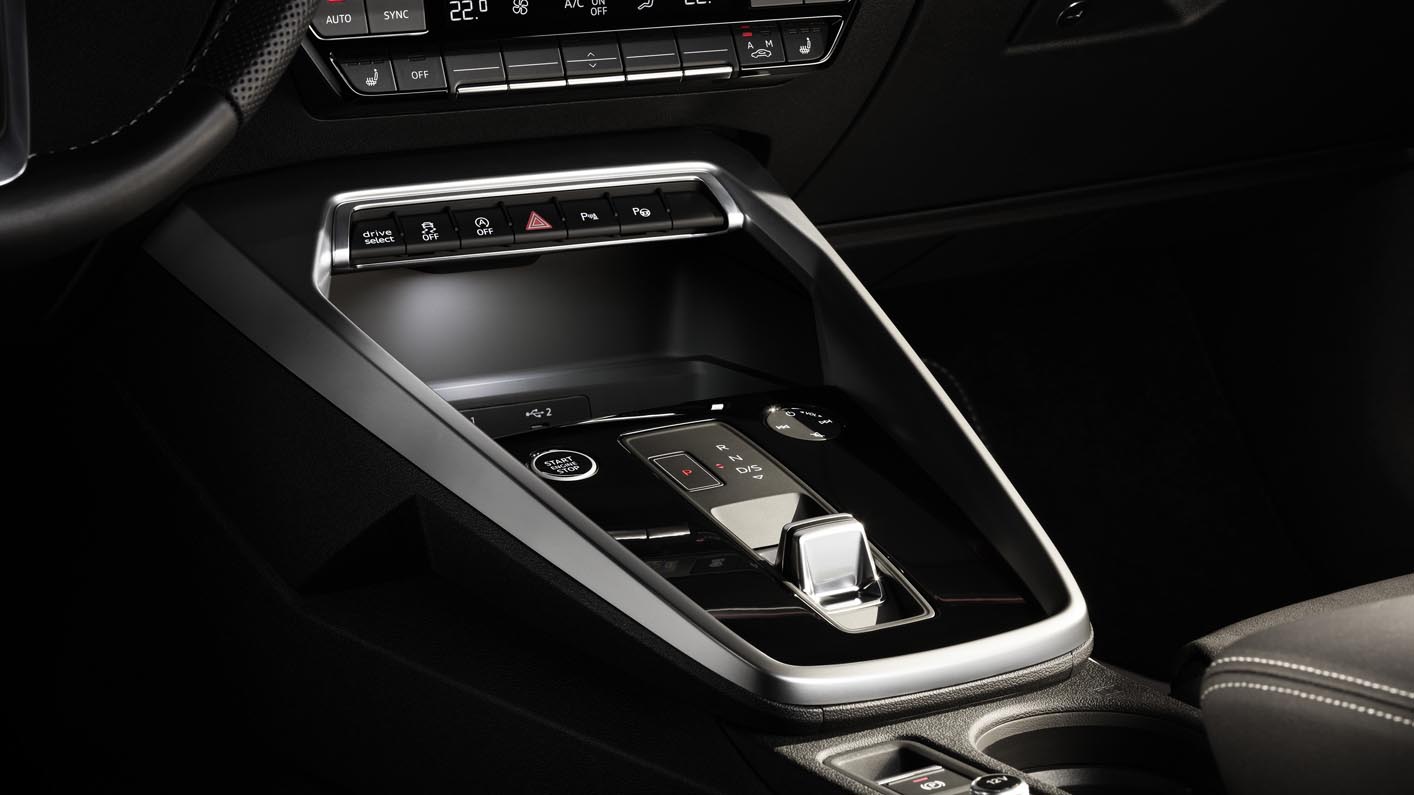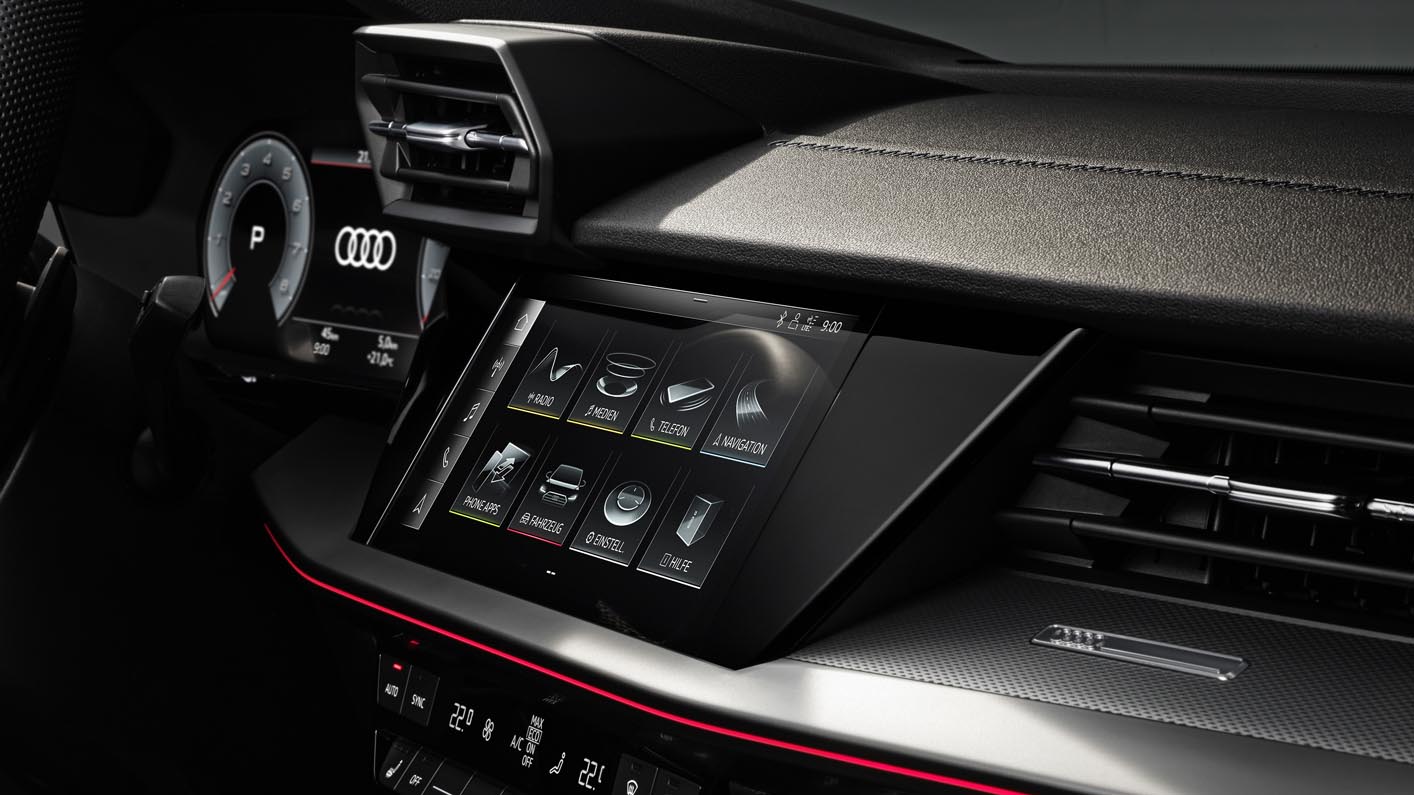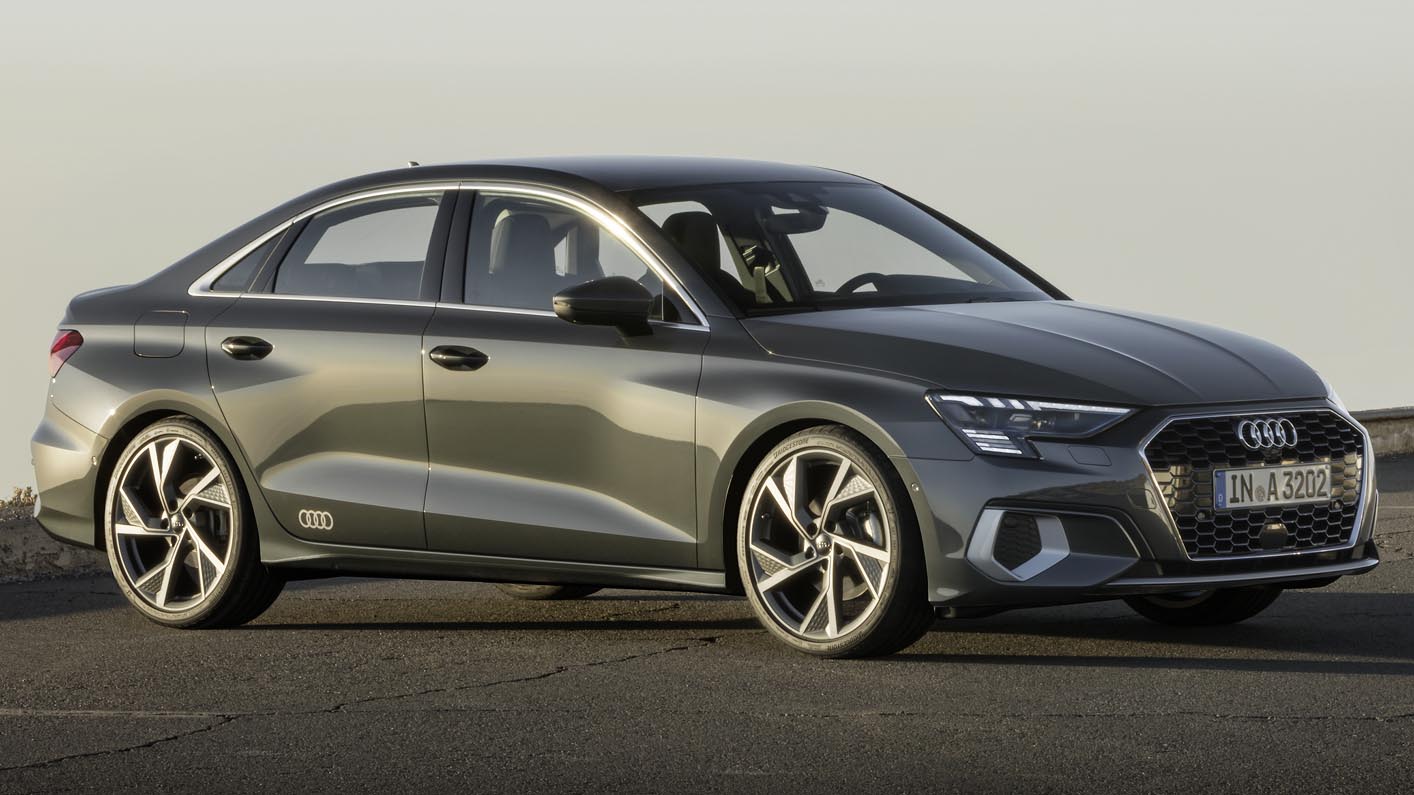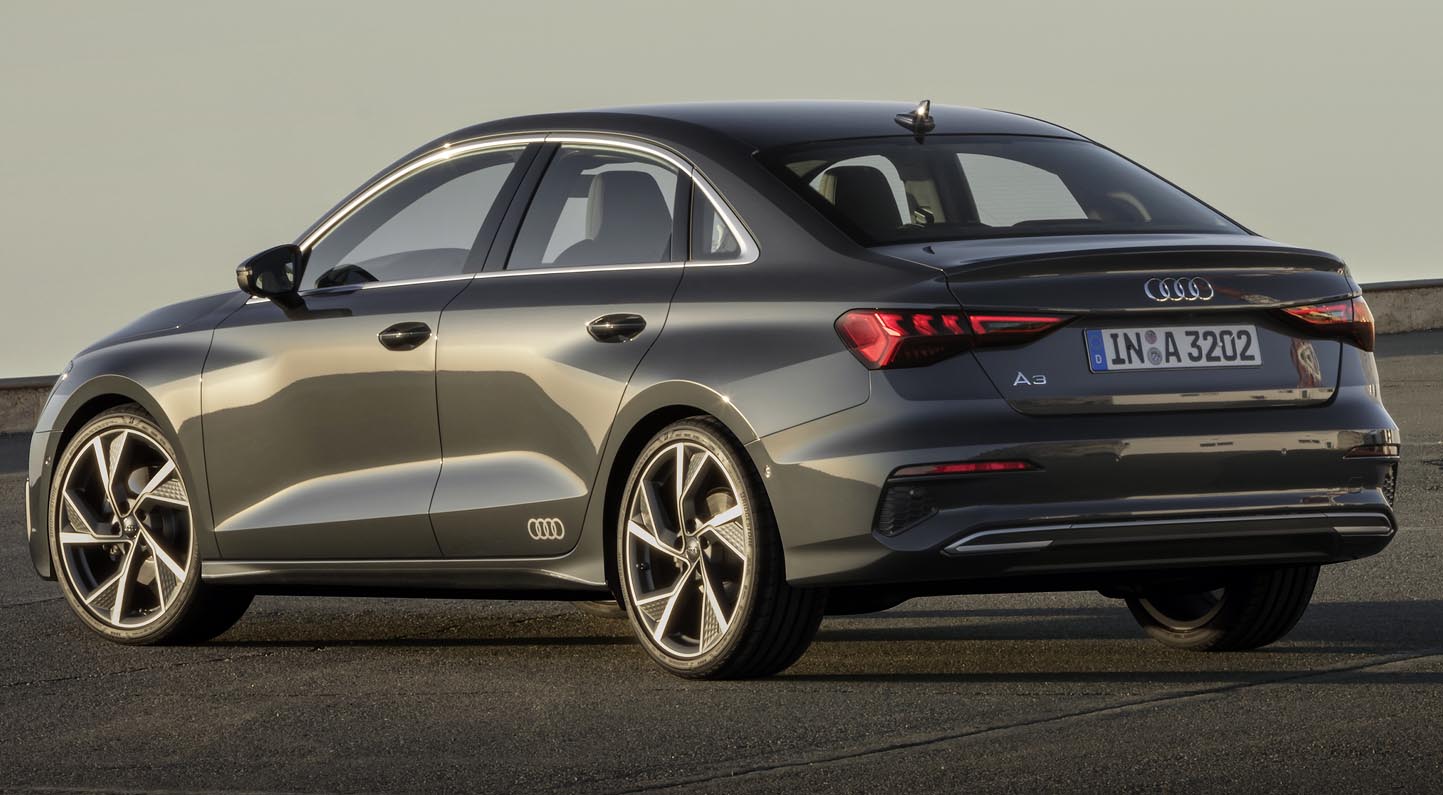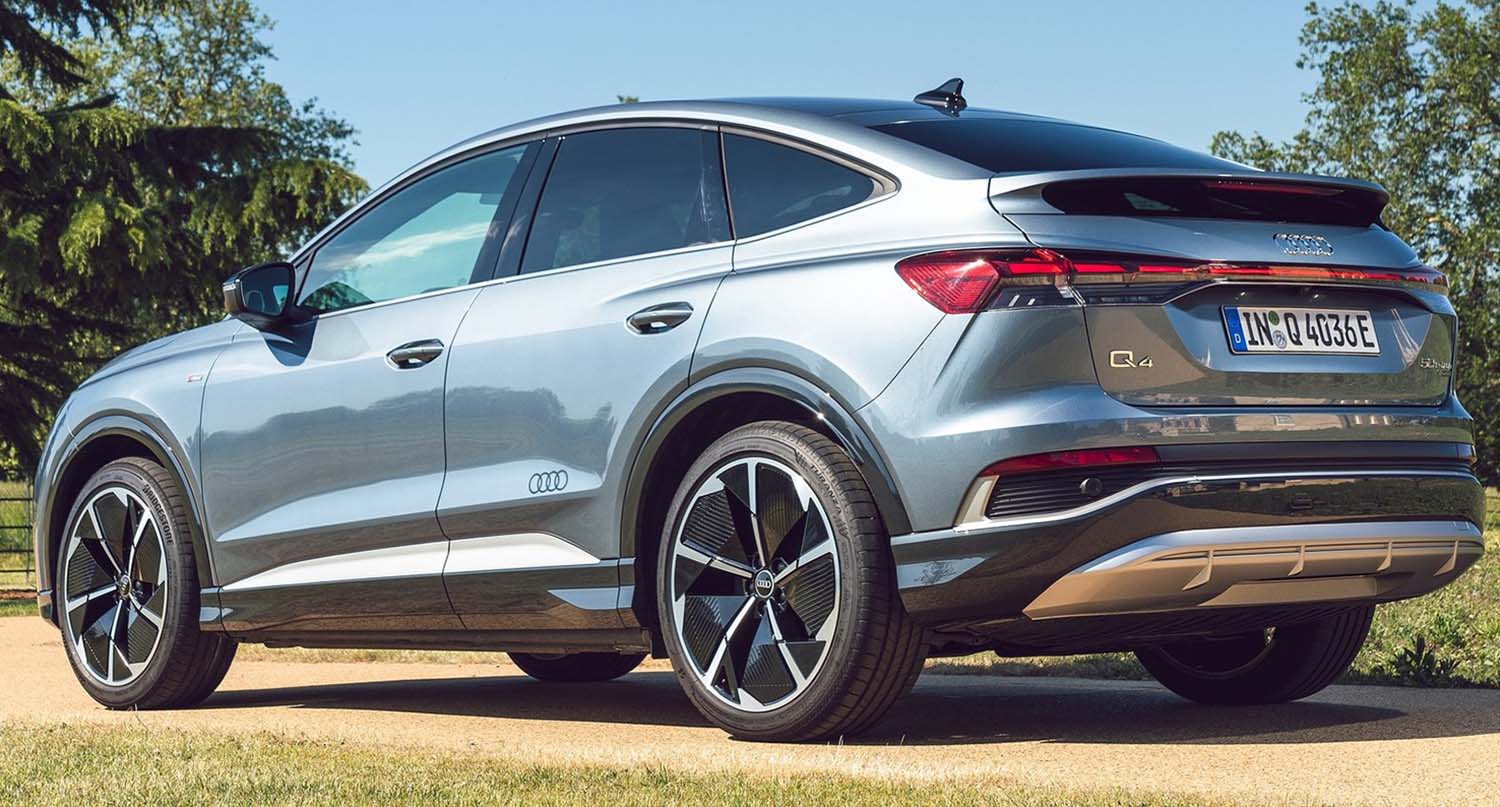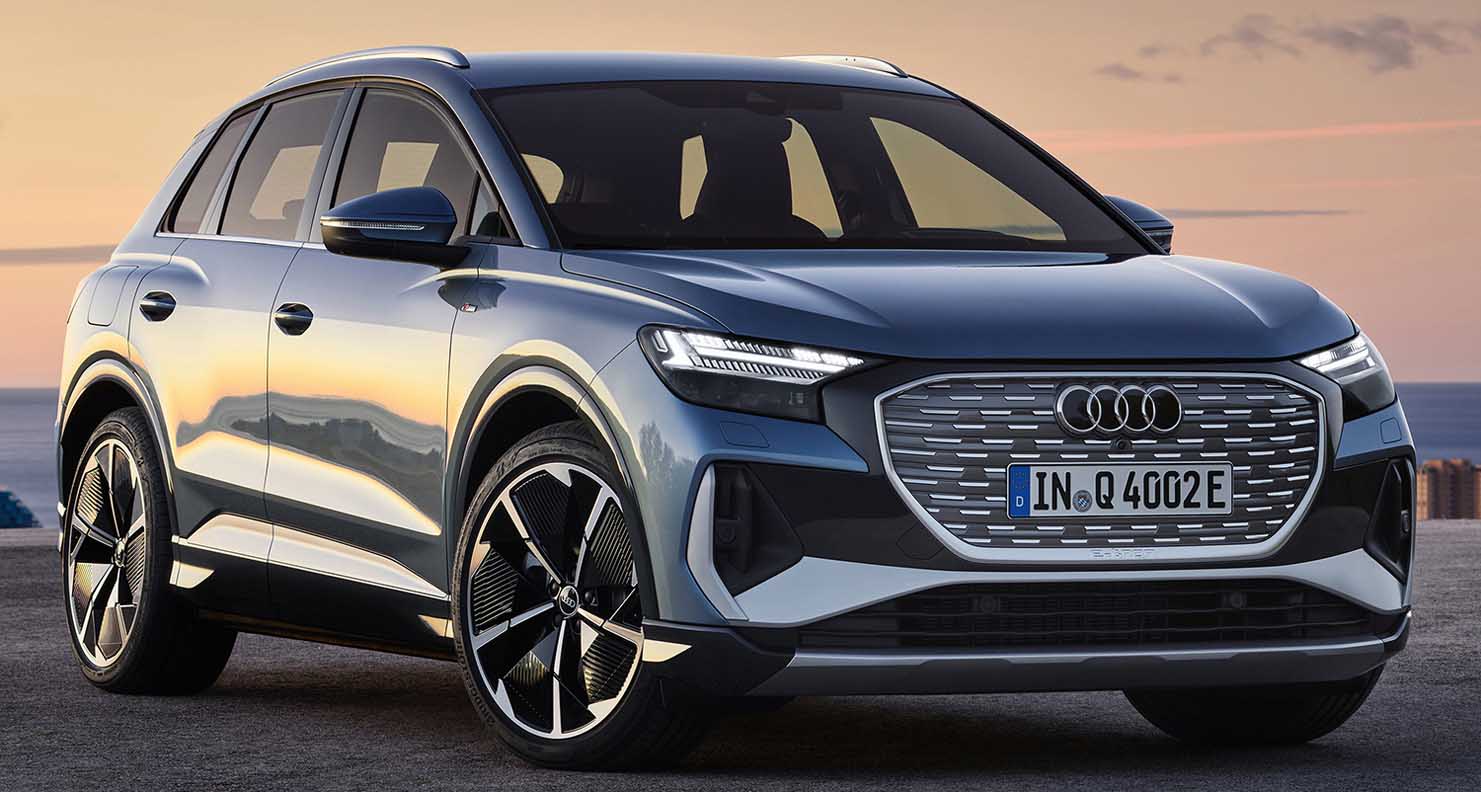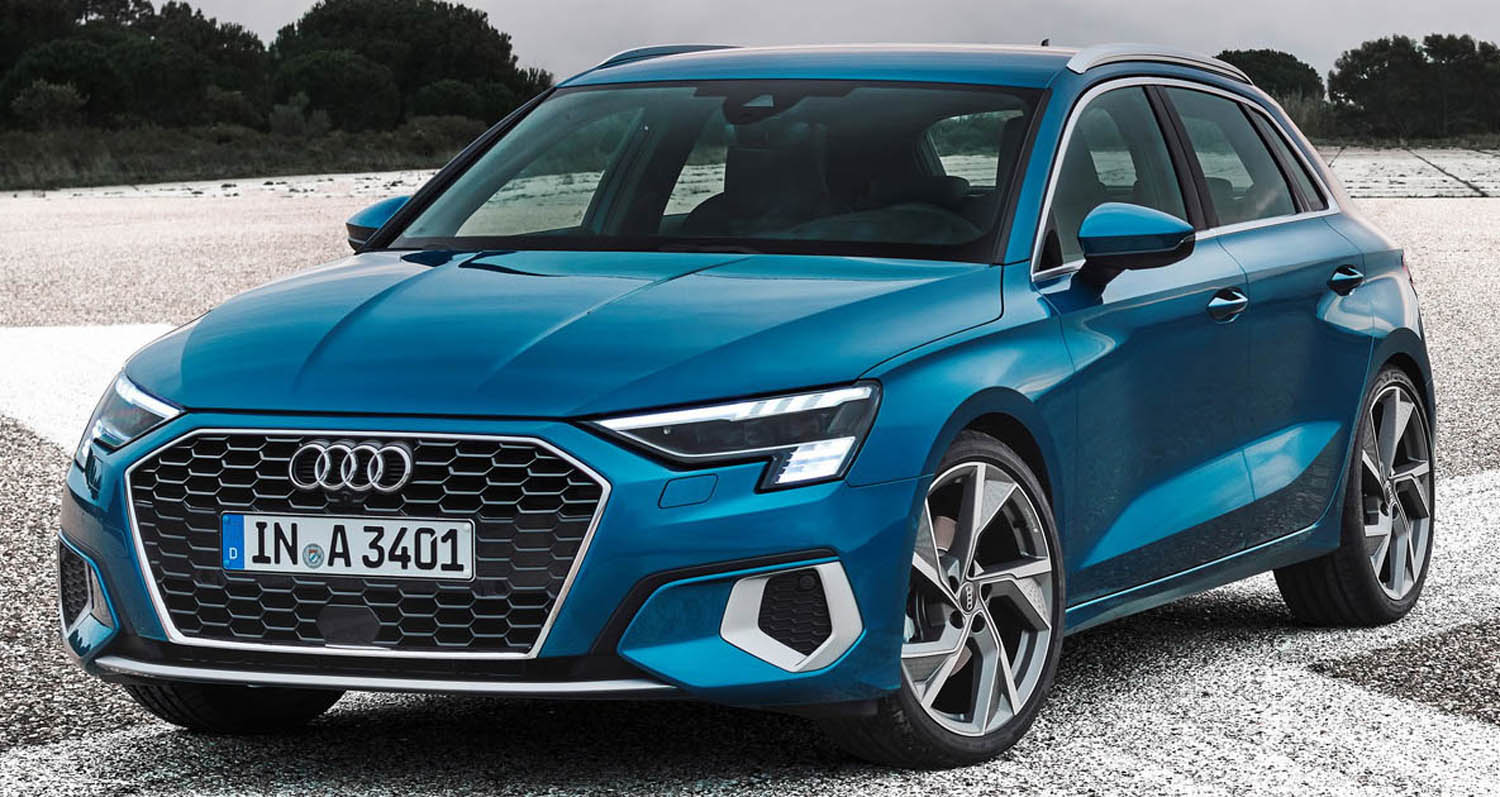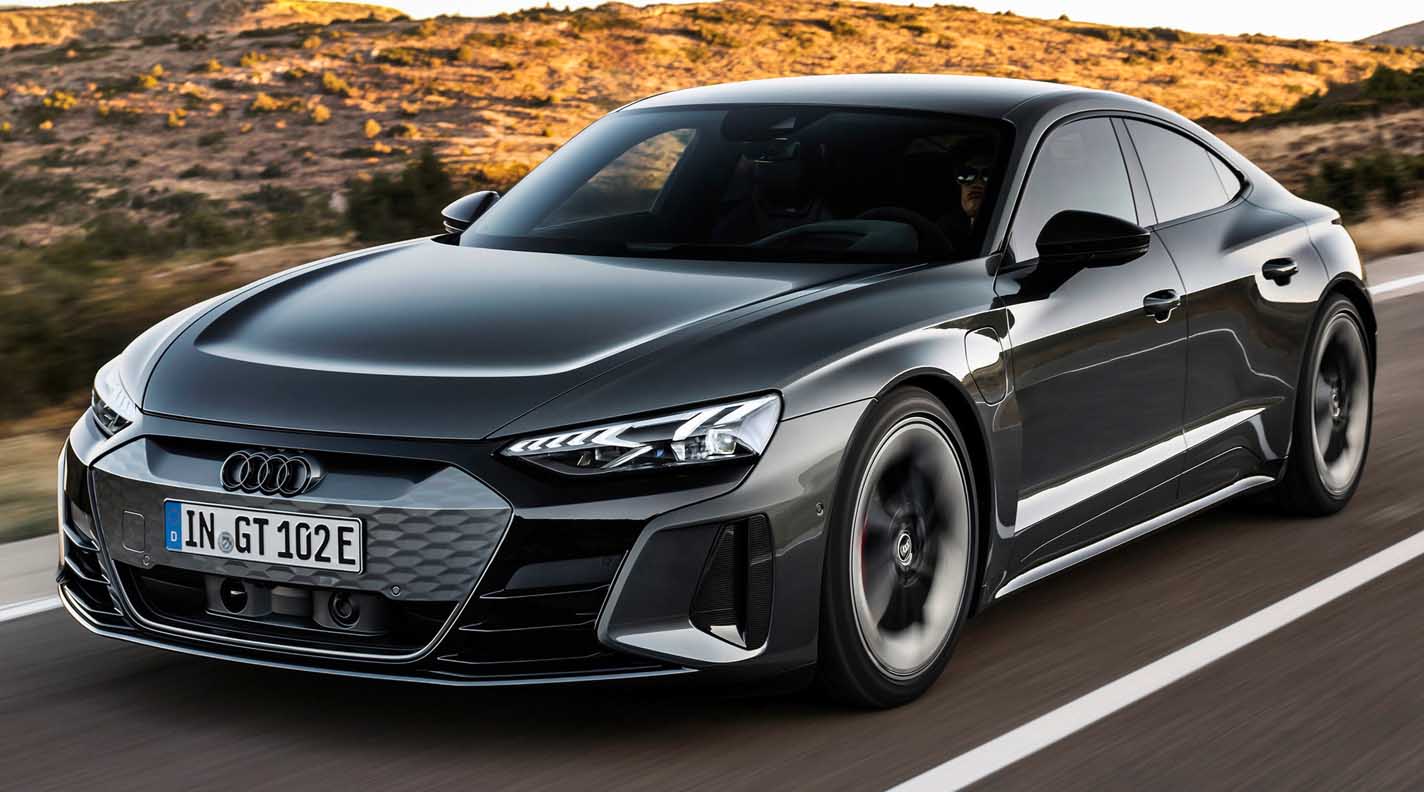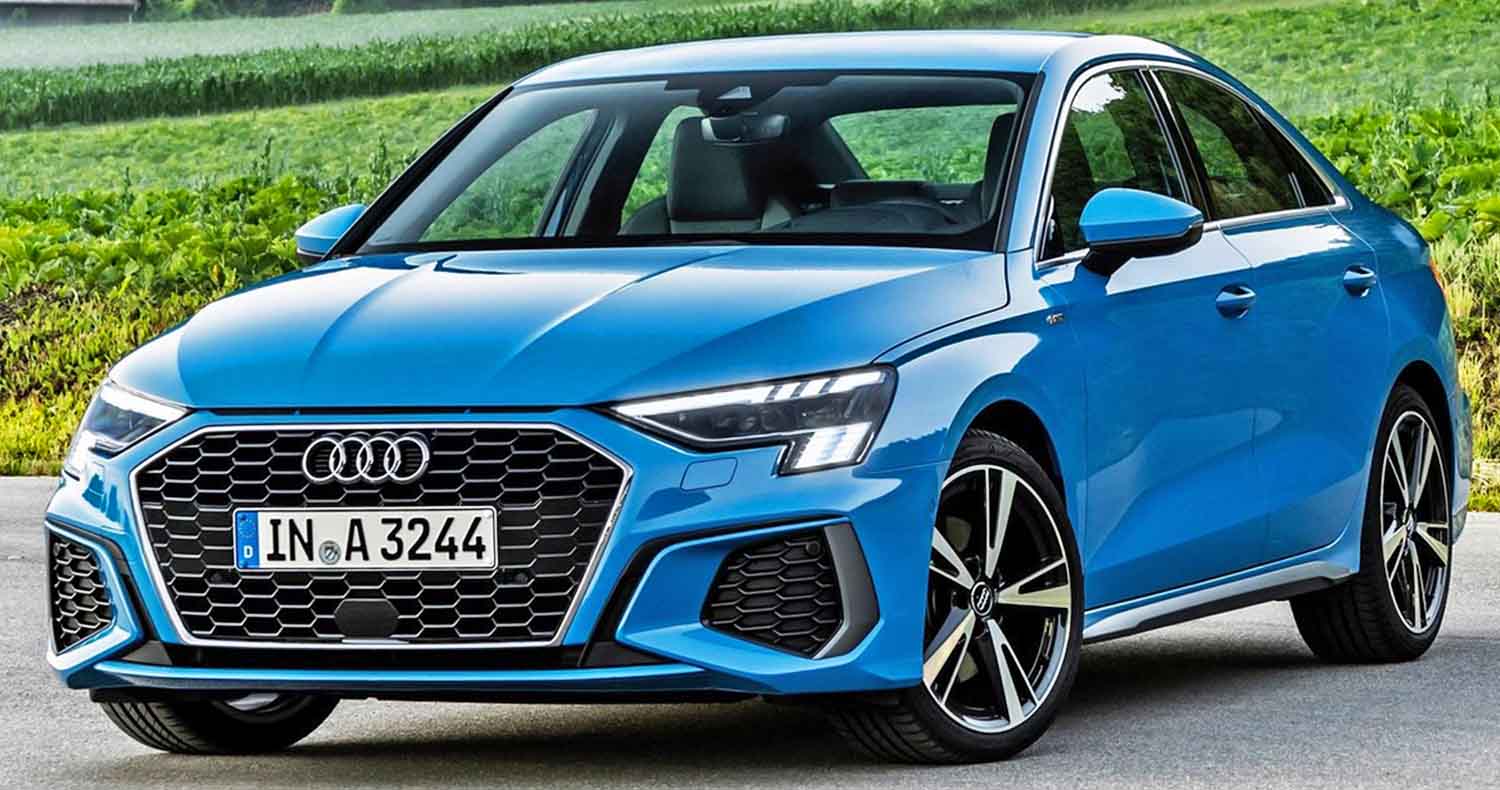
The second generation of an Audi success story is here – the A3 Sedan. The compact four-door model is digitally and fully connected – from the infotainment through to the assist systems. Beneath the elegant body, new drives and refined suspension tuning ensure a driving experience that is as efficient as it is dynamic. The A3 Sedan will be on the lots of European dealerships beginning in summer 2020.
The new Audi A3 Sedan is presented in a sporty, elegant look. Compared with its predecessor, it is now 4 centimeters (1.6 in) longer at 4.50 meters (14.8 ft), while its wheelbase remains unchanged. Its width has increased by 2 centimeters (0.8 in) to 1.82 meters (6.0 ft) and it is now 1 centimeter (0.4 in) taller at 1.43 meters (4.7 ft). This has yielded an increase in headroom – a good 2 centimeters (0.8 in) in the front thanks to the lower position of the driver seat – and some more elbow room. At 425 liters (15.0 cu ft), the luggage capacity is exactly the same as in the predecessor model.
Powerful and elegant: The exterior
The front is dominated by a large Singleframe with honeycomb grille that is flanked by striking headlights. On the outside, they form trapezoidal angles that are drawn downward. In the top model with Matrix LED technology, this is where the new digital daytime running lights are housed. They consist of a pixel array made up of 15 LED segments that can be actuated individually and give the various versions of the A3 Sedan a specific signature.
With the A3 Sportback, the body line running above the sill rises towards the rear lights before the rear wheel arch, thus accentuating the short rear end. The body line on the Sedan, by contrast, extends up to the rear bumper. This emphasizes its length – 15 centimeters (5.9 in) longer than the Sportback – and gives the flank an elegant appearance. The concave surface under the broad body shoulder further accentuates the quattro blisters and the sill. This creates an intensive play of light and shadow. The roof line slopes down from the B-pillar dynamically – just like on a coupé – and finishes in a striking spoiler on the tailgate. Optionally available in carbon, this provides a visual accent and, in so doing, emphasizes the powerful appearance of the four-door model.
Streamlined body
The aerodynamics benefit from the higher rear end compared with the predecessor as well as the large diffuser. As a result, the new Audi A3 Sedan with the 2.0 TDI 110 kW (150 PS) achieves a Cd value of 0.25 and is therefore 0.04 Cd points better than the first generation. The controllable cooling-air inlet with two electrically actuated louver modules behind the Singleframe also contribute to this. They regulate the flow of air intelligently and according to the situation. In addition, the paneled underbody, the exterior mirrors with improved aerodynamics, and the active brake cooling reduce air resistance and make for a streamlined vehicle.
Focused and digitalized: The cockpit
The cockpit of the Audi A3 Sedan is entirely focused on the driver. This begins with the interior design and ends with the display and control elements. Thus, the instrument panel with the central MMI touch display is inclined slightly toward the driver. It has a 10.1-inch diagonal and is intuitive to operate. As standard, it includes handwriting detection as well as natural language control that can optionally draw on the capabilities of the cloud. The 10.25-inch instrument cluster behind the steering wheel is digital even in the basic model. As the Audi virtual cockpit plus, it measures 12.3 inches and offers three different views, including sporty graphics with inclined digits and a particularly dynamic layout. The RPM and speed are shown here as bar diagrams with angular red graphical elements. Upon request, a head-up display complements the display concept, whereby it projects important information onto the windshield in the driver’s direct field of vision.
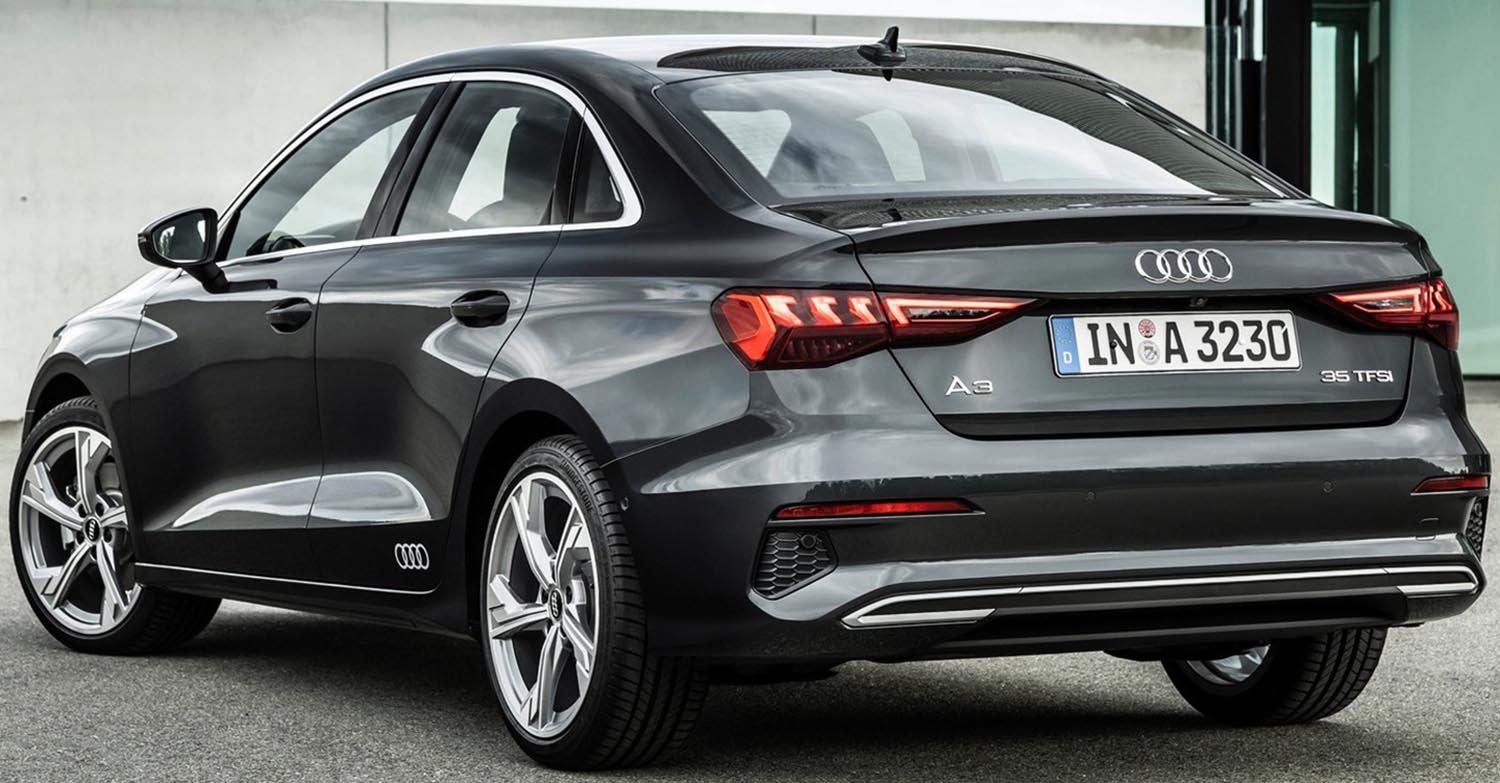
Highly connected: From infotainment to driver assistance
The top infotainment system in the new A3 Sedan is the MMI Navigation plus, which uses the third-generation modular infotainment platform (MIB 3). The MIB 3 boasts computing power ten times higher than in the predecessor model, connects the car via LTE Advanced speed, and connects the smartphones of the passengers to the Internet via Wi-Fi hotspot. The MMI Navigation plus offers a multitude of Audi connect services as standard, including online traffic information, news, and additional information such as photos, opening times, and user reviews relating to points of interest.
Car-to-X services that make use of the swarm intelligence of the Audi fleet are also part of the portfolio. They report hazardous areas or speed limits, for example, to vehicles with the corresponding equipment or find free parking spaces at the side of the road. If the car is switched off, the myAudi app continues navigation from the car on a smartphone. This way, customers reaches their destination directly.
The Audi A3 Sedan is also connected to the smartphone via the Audi smartphone interface, which integrates iOS and Android cell phones with Apple Car Play and Android Auto in the MMI, as well as via Audi phone box. The latter connects the device to the car antenna and can charge it inductively. What is more, the A3 Sedan can be locked and unlocked as well as started via an Android smartphone with the Audi connect key. Personalization allows up to six users to store their preferred settings in individual profiles, including those for the seat, climate control and media. The DAB+ digital radio comes as standard. Options include online radio and the hybrid radio, which automatically switches between FM, DAB, and the online stream depending on a station’s signal strength, thus ensuring optimum reception. Beginning in the middle of the year, the Amazon Alexa voice assistant will complement the offering.
The driver assist systems are also particularly effective thanks to the close networking. In the Audi pre sense front system, the camera behind the interior mirror works together with the front radar to prevent accidents, or at least reduce their severity. The standard collision avoidance assist also uses the data from this sensor system. Adaptive cruise assist, an innovation from the full-size class, supports drivers with longitudinal and lateral guidance. The efficiency assist notifies them when it would be sensible to take their foot off the accelerator. To do so, it evaluates information including the navigation data. The exit warning, the cross-traffic assist and the surround view cameras that will follow shortly after the market launch are also useful in in urban traffic.
Three engines at ramp-up: The drives
The new Audi A3 Sedan is available with a choice of two TFSI engines and one TDI engine at launch. One thing they all have in common is high efficiency. The 35 TFSI, a 1.5-liter direct injection engine, produces 110 kW (150 PS) and is available in two versions – with a newly developed six-speed manual transmission and with a quick-shifting seven-speed S tronic.
Besides the cylinder on demand technology, the powertrain in conjunction with the S tronic dual-clutch transmission uses a 48-volt mild hybrid system. It recovers energy during deceleration, supports the engine with up to 50 Nm (36.9 lb-ft) of torque when driving off and accelerating from low engine speeds and allows the A3 Sedan to coast with the engine switched off in many situations. In everyday driving, it reduces consumption by up to 0.4 liters (0.1 US gal) per 100 kilometers (62.1 mi).
The 2.0 TDI with 110 kW (150 PS) also works in conjunction with a seven-speed S tronic, whereby gear shifts are performed via a new switch using shift-by-wire technology.
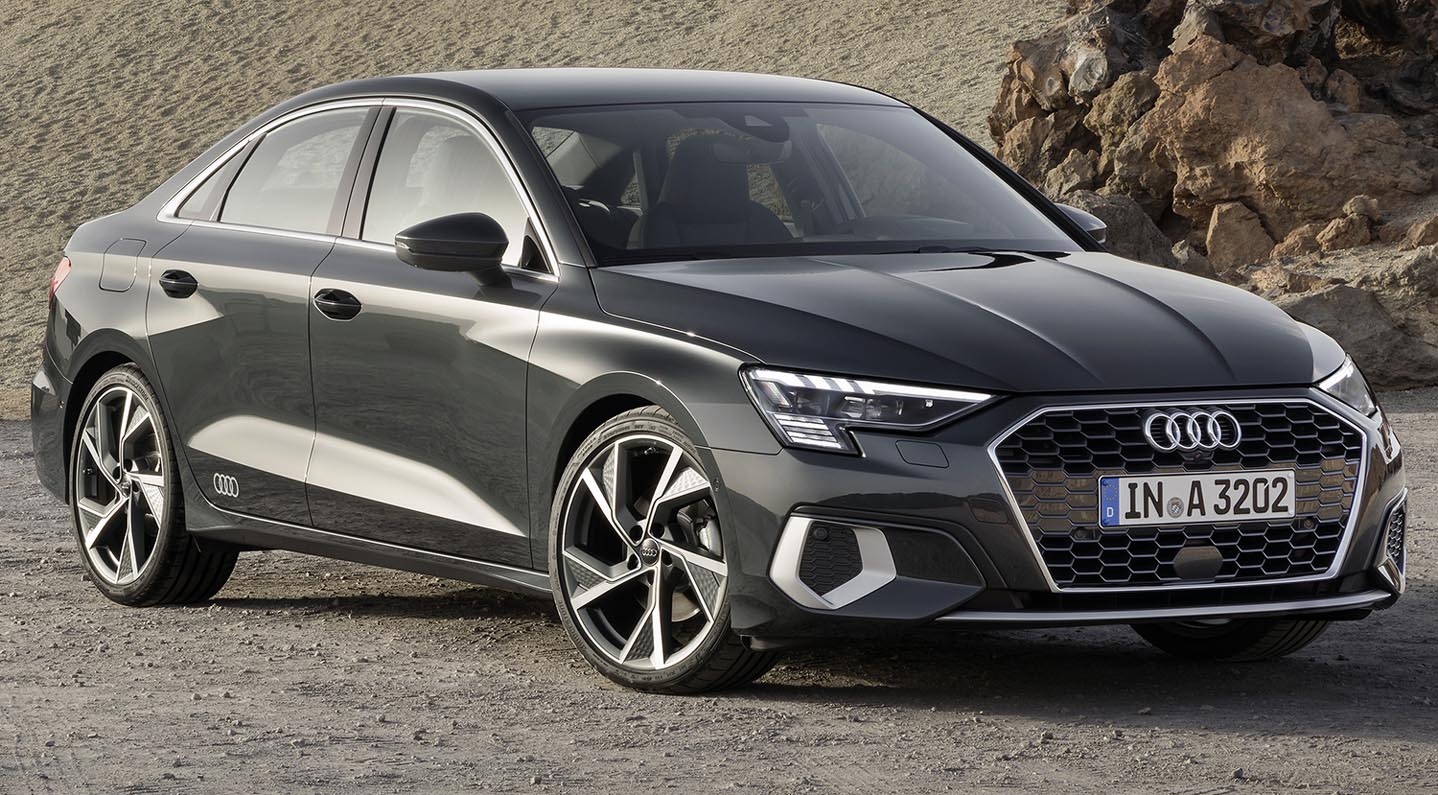
Comfortable and dynamic at once: The suspension
The suspension of the new Audi A3 Sedan has been tuned to be sporty and harmonious – a touch more precise than in the predecessor model. To a large degree, this precision and reaction speed is thanks to the central dynamic handling system that ensures optimal interaction between all the components relevant to the transverse dynamics. As an alternative to the standard setup, there is a sport suspension and a suspension with controlled dampers. The latter offers a wide spread between highly comfortable roll motion and agile handling. The Audi drive select dynamic handling system also allows the driver to experience different levels of suspension tuning in their A3 Sedan – from comfort-oriented and distinctly dynamic right through to particularly fuel-efficient. This also brings about changes in the characteristics of the throttle response and the progressive steering, for example, which varies its ratio depending on the steering angle.
From EUR 27,700: Prices and market launch
Presales of the new Audi A3 Sedan will begin at the end of April 2020 in Germany and many other European markets. Deliveries will commence in the summer. Prices for the 35 TFSI with 110 kW (150 PS) start at EUR 29,800. Shortly after the market launch, an entry-level gasoline engine will follow with a list price of EUR 27,700.
Exterior and Lighting
The new Audi A3 has a sporty and taut road stance. The front section is dominated by a wide, hexagonal Singleframe with a honeycomb grille. It symbolizes the dynamic character of the premium model just as clearly as the large, angular air inlets whose depth gives them a sculptural effect.
The shoulder line runs from the headlights to the rear lights in a tapered shape. The surface below it falls inward, accentuating the quattro blisters and highlighting the body shoulder. With its concave side, the new A3 is showcasing a completely new element of the Audi design. This creates an intensive play of light and shadow, which is mainly due to the strong contour in the sill area.
With the Sportback, the lower body line distinctly rises once more before the rear wheel arch, creating a particularly dynamic effect and emphasizing the short rear end. The heavily inclined C-pillars also give the compact five-door car a pronounced forward thrust – they are virtually squatting on the rear wheels. A long roof edge spoiler provides shade for the rear window, making it appear particularly flat. On the new Audi A3 Sedan, the lower body line extends up to the rear bumper. In conjunction with the striking shoulder line, this gives the sides a very elegant appearance and emphasizes the length of the new model. The roof line slopes down from the B-pillar just like on a coupé and finishes in a striking spoiler on the tailgate.
On both models, the three-dimensional design of the rear end makes it look extremely wide. This impression is reinforced by the circumferential shoulder line, the wedge-shaped rear lights, the implied air outlets at the wheel arches, the diffuser, and the trapezoidal tailpipe trims.
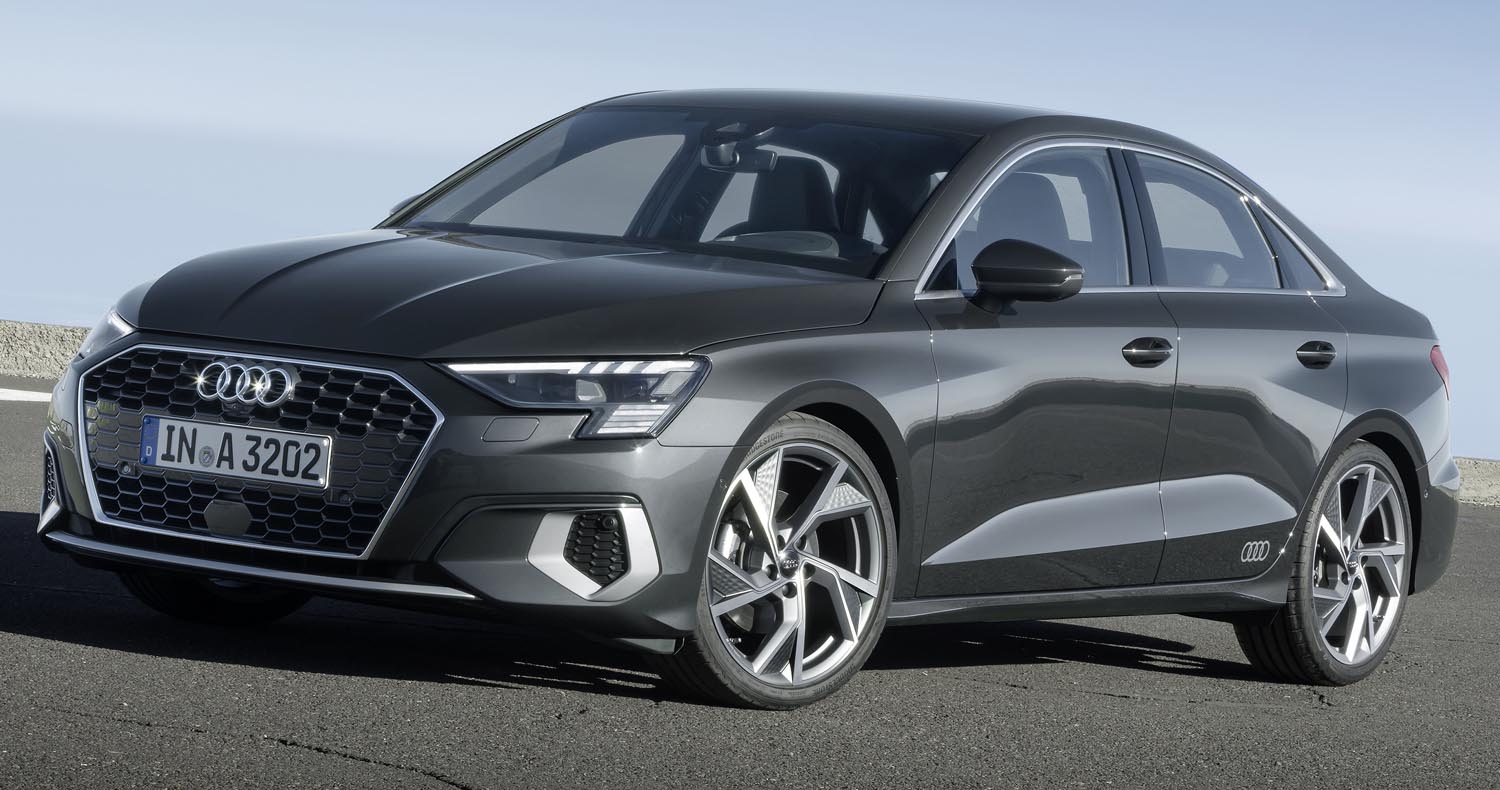
Signed: digital daytime running lights
The headlights are available in three versions. Even in the basic model, they use LED technology – apart from the turn signals. With their flat, wedge-like shape, the lights underline the sporty character of the new A3 models. Trapezoidal angles at their outside corners are drawn downward. As the top-of-the-line version in the range, the Matrix LED headlights incorporate a lighting innovation from Audi in these angles – digital daytime running lights. Their matrix of LED elements in a three-by-five arrangement can be actuated variably, which means that the different versions of the new A3 each have specific signatures. While horizontal lines are characteristic of the basic model, two vertical LED lines emphasize the sportiness of the S line exterior. In addition, the Matrix LED headlights offer intelligently controlled, anti-glare high beam light, dynamic turn signal light, and many other functions, including new animations when the car is unlocked and when exiting the car.
Interior
Black-panel look on the instrument panel and center console, stylish contrasting stitching, striking door openers, and a new shifter design – the interior of the A3 Sportback and the A3 Sedan is sporty and of high quality. Precise horizontal lines and surfaces with a clear design emphasize the width of the cockpit. This is also achieved by the striking air vent door strip on the passenger side and the curved trim strip below. On the driver’s side, the air vents form an impressive unit with the cover of the instrument cluster. The elements merge here, underlining the model’s sporty character.
Many of the design motifs make logical reference to each other and to the exterior. Two examples: The hockey stick shape of the handles for opening the doors are reminiscent of the headlights and rear lights. With their flat, pentagonal shape, the air vent doors on the driver’s side take on the motif of the air inlets on the front end.
The cockpit is totally focused on the driver. It uses familiar elements from the brand’s full-size class models and is equipped with a 10.1-inch touch display as standard. The screen is embedded in a trapezoidal black panel trim that takes up the center area of the instrument panel. When it is switched off, the display is hardly noticeable. It is inclined slightly toward the driver, as is the newly developed control unit for climate control with its physical buttons that is located below. The black-panel surface is continued to the left of the steering wheel and further highlights the width of the cockpit.
The design of the center tunnel console is also particularly ergonomic. There is an innovative shifter integrated in its black-panel surface that offers the driver a completely new operating experience. Using shift-by-wire technology, the compact controller can be pushed and pulled to control the basic functions of the seven-speed S tronic. Next to it is a further innovation: a round, sensory volume control that reacts to circular finger movements. A large stowage compartment contains the inductive charging area of the Audi phone box and two USB ports.
Space Concept and Body
The new A3 models offer more space and functionality combined with compact external dimensions. The Sportback measures 4.34 meters (14.2 ft) in length and 1.82 meters (6.0 ft) in width (without mirrors), and has therefore grown by just over three centimeters (1.2 in) compared with the predecessor model. The passengers benefit from this directly: They have more elbow room at the front and rear and more shoulder room in the rear. The new Audi A3 Sedan has the same width, but measures 4.5 meters (14.8 ft) in length, making it four centimeters (1.6 in) longer than the predecessor model.
Both models measure 1.43 meters (4.7 ft) in height without the roof antenna. Like the wheelbase of 2.64 meters (8.7 ft), the height is identical to the predecessor model. By contrast, the slightly lower seat position for the driver is a new feature. It underlines the sporty character of the new A3 and benefits the headroom in the first seat row. The Sedan also gives the passengers in the second row one more centimeter (0.4 in) of headroom than before.
In addition to the standard seats, Audi offers the new sport seats with high side bolsters and integrated head restraints, which are standard in the interior S line. Seat heating, electric seat adjustment with a memory function, and a lumbar support with a pneumatic massage function are available in addition. There is even a wide range of steering wheels – round or flattened, with standard or large multifunction buttons, and with or without shift paddles, which are standard in combination with the S tronic.
Depending on the position of the rear seats, the luggage compartment in the new A3 Sportback has a capacity of 380 to 1,200 liters (13.4-42.4 cu ft). The loading floor can be inserted at different heights, and the rear shelf is located beneath it. On request, Audi will deliver the storage and luggage compartment package and an electrically powered tailgate, which can be opened and closed with a foot motion. The luggage compartment in the Sedan has a capacity of 425 liters (15.0 cu ft). Here, too, a tailgate that works with gesture control is available as an option. With the most powerful engine variants, both models have a towing capacity of up to 1,600 kg (3,527.4 lb) (braked, at a 12 percent incline).
The body is extremely impact resistant, rigid, and acoustically comfortable. With the 1.5 TFSI, the A3 Sportback has an unladen weight (without driver) of just 1,280 kilograms (2,821.9 lb), while the A3 Sedan weighs only slightly more at 1,285 kilograms (2,832.9 lb). In the passenger cell, components made of hot-formed steel, which combine high strength and low weight, form a strong compound. They account for around 30 percent of the weight of the body shell in the Sportback and Sedan. The engine hood is made of aluminum. Thanks to complex soundproofing and sophisticated aeroacoustics, it is very quiet in the interior of the new A3. Privacy glazing for the rear is available as an option: The windows are tinted and make it difficult to look into the vehicle interior.
With drag coefficient values starting from 0.25 for the Audi A3 Sedan and 0.28 for the A3 Sportback, both models are particularly streamlined, which reduces CO2 emissions and fuel consumption. Aerodynamics developers and designers started working together closely at a very early stage and optimized many areas of the body, including the exterior mirrors and the underbody, which received large-area paneling and finishes in a diffuser. With the Sedan, the relatively high rear end and the large spoiler on the tailgate have a further positive impact on the aerodynamics.
The 110 kW TDI engine variant has a controllable cool-air inlet This involves two horizontally arranged louver modules behind the Singleframe that are actuated electrically. They regulate the flow of air intelligently and according to the situation, which benefits both the cooling output and the streamlined airflow. The brake cooling with a neutral drag coefficient, where the air is guided from the engine compartment through the wheel arch shells to the brakes, is another new feature. This solution is more aerodynamically efficient than the conventional air duct from the underbody.
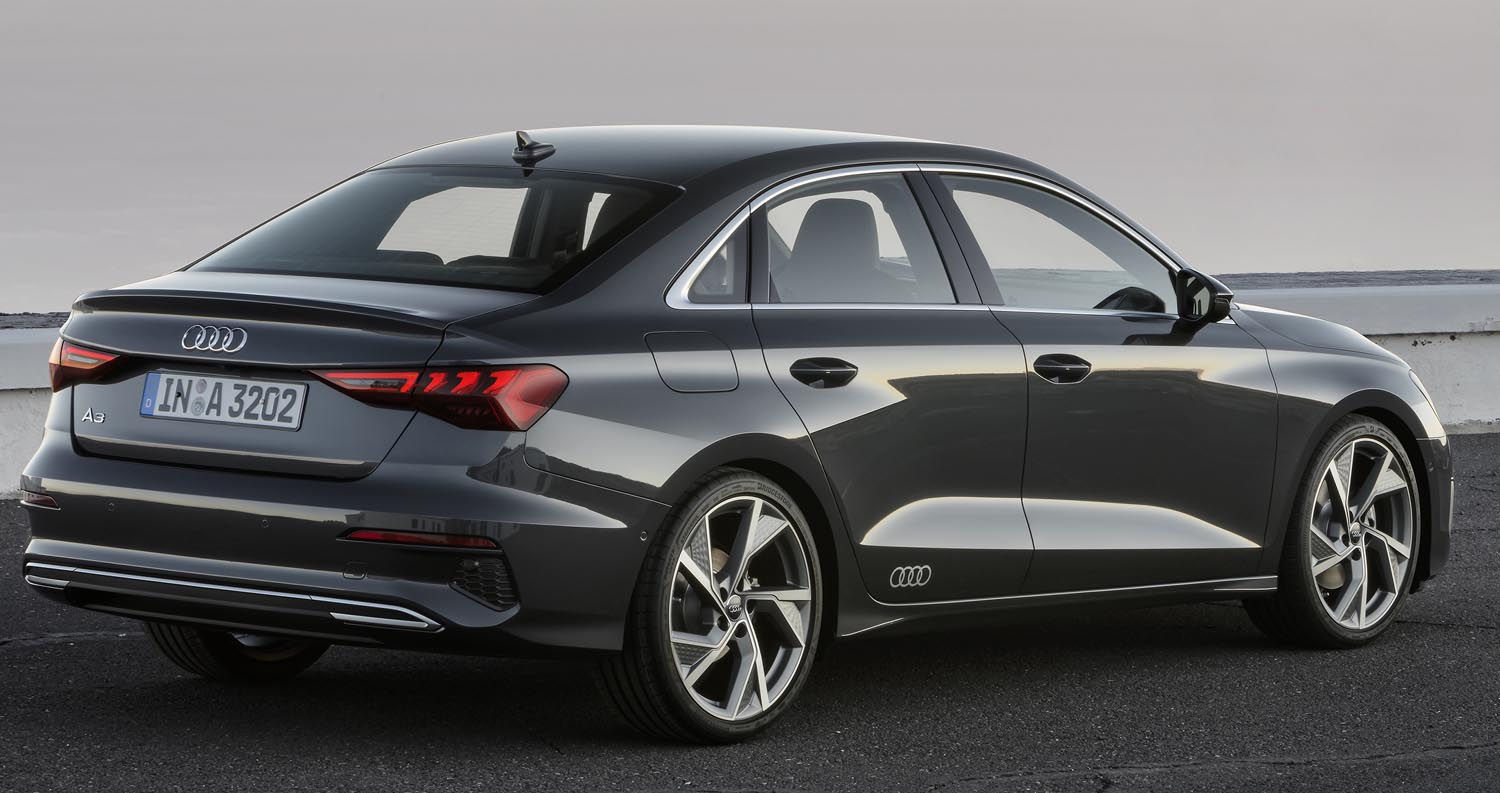
Controls and Displays
Digital, easy to understand, and intuitive: The new A3 models feature a newly developed control and display concept with a flat menu structure and symbols that are familiar from smartphones. Audi has replaced the rotary pushbutton on the center tunnel with a large MMI touch display that provides acoustic feedback. It has a 10.1-inch diagonal, is configured as an MMI radio plus as standard, and is used to control the infotainment system as well as a number of comfort functions. The driver receives acoustic feedback when selecting a function. The system also allows the driver to enter text in handwriting: It recognizes individual letters, cursive writing, whole words, and letters written on top of each other. The MMI search provides a list of suggestions even after just a few characters are entered.
Alternatively, the system can be controlled by natural language voice control. This feature also comes as standard. The A3 turns into an intelligent conversation partner: the driver can formulate his instructions freely and the dialog manager responds to them. For example, the system understands questions such as “Where is the nearest Italian restaurant?” and displays matching restaurants nearby. If the customer books the Audi connect navigation & infotainment plus package, the system also performs an online comparison, which improves the rate of recognition and the quality of the results.
The new A3 models also come with a digital instrument cluster as standard. It has a 10.25-inch diagonal and is operated via the multifunction steering wheel. In combination with MMI navigation plus, the displays appear in the Audi virtual cockpit, which has many additional functions, such as the large navigation map display. The larger Audi virtual cockpit plus with a 12.3-inch diagonal and a resolution of 1,920 x 720 pixels is even more attractive. It offers three different views, including graphics with a particularly sporty look.
A head-up display completes the control and display concept of the new A3. It projects important information, including from some connect services and assist systems, into the driver’s immediate field of vision on the windshield. The image appears to be at a distance of 2.2 meters (7.2 ft).
Infotainment and Audi connect
The control and display system of the new Audi A3 is powered by the latest generation of the modular infotainment platform, MIB 3. Its computing power is ten times higher than that of its predecessor system, MIB 2. The new MIB 3 works with the Online Connectivity Unit (OCU), which is equipped with an integrated eSIM and a Wi-Fi module for the passengers’ mobile devices. The OCU performs all connectivity-related tasks, for example fast data transfer. Individual settings can be stored in up to six user profiles – from climate control and the seat position to frequently selected navigation destinations and frequently used media.
More precise: the navigation
Upon request, Audi delivers MMI navigation plus, which features the same functions as the full-size class. The navigation system can make intelligent route suggestions on the basis of the journey history. In doing so, it takes statistical empirical values based on time of day and traffic density into account, as well as real-time data on the traffic situation. Should the data stream be cut off, for example when driving through a tunnel, onboard route guidance, which runs in parallel, steps in.
The basic services from Audi connect add online traffic information to the navigation, enrich points of interest with photos, opening hours, and user reviews, and provide a weather forecast for the navigation destination. In combination with the Audi connect navigation & infotainment plus package, high-resolution satellite images from Google Earth and detailed 3D models of many major European cities make orientation easier. Another highlight – and new to the Audi range – is the online traffic information plus service, which will follow soon. Here, forecasts as to how the traffic situation will develop make route guidance even more flexible and precise. In addition, the navigation system can specify the lanes in which stationary or free-flowing traffic can be expected.
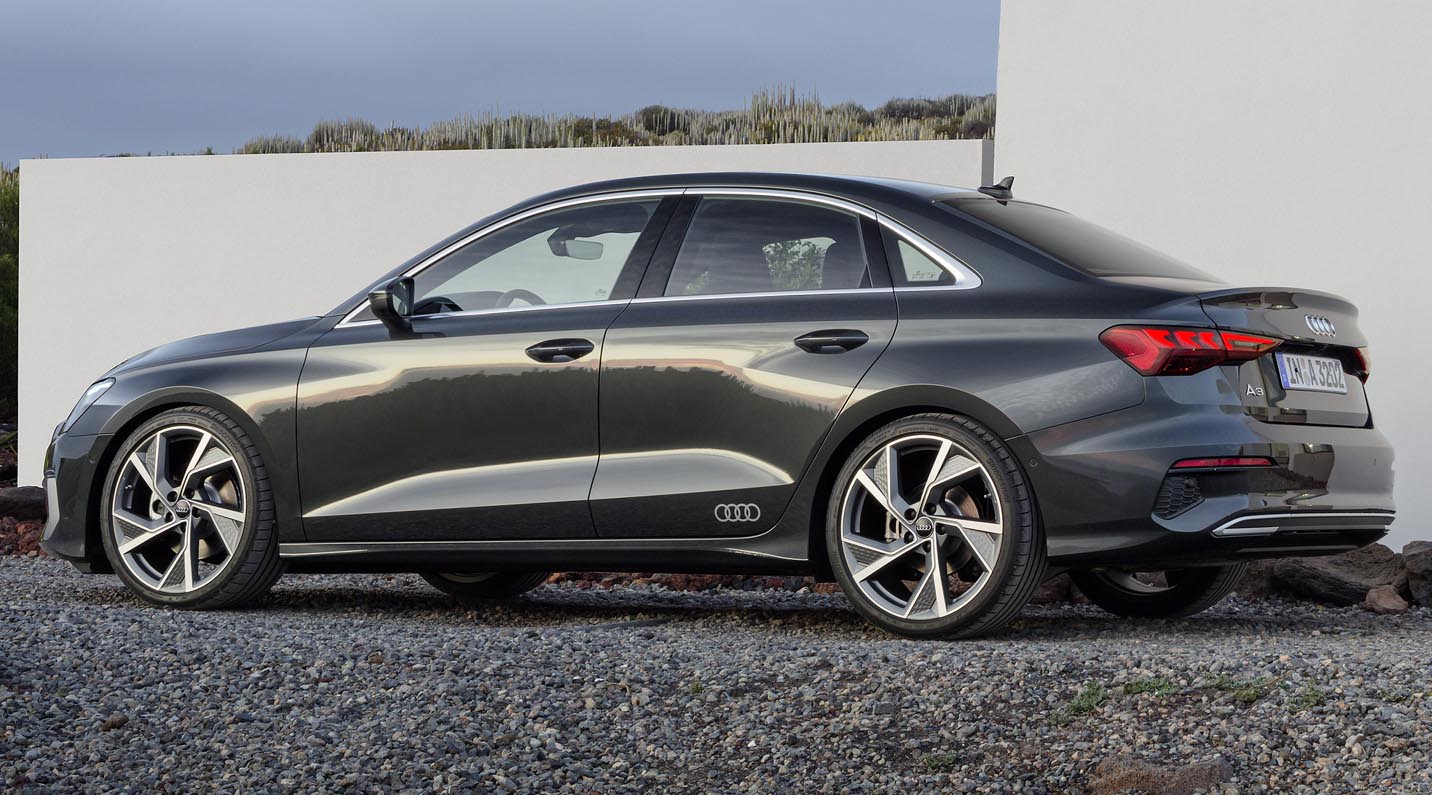
Communicated: Car-to-X
The connect portfolio also includes multiple car-to-X services that make use of the swarm intelligence of the Audi fleet. Provided the local infrastructure is available, they help with finding free parking spaces on the roadside or allow the driver to surf the green wave by communicating with the city’s main computer. The information on the traffic light phases is displayed to the driver in the Audi virtual cockpit. This allows drivers to adjust their speed preemptively, which increases efficiency and improves traffic flow. The onboard camera and the vehicle sensor system also detect hazardous areas and speed limits and communicate them to vehicles with the corresponding equipment. Communication takes place via the cellular network.
Synchronized: the myAudi app
Many Audi connect functions are bundled in the free myAudi app, which connects the customer’s smartphone to the A3 Sportback and the A3 Sedan. It can be used, for example, to transfer navigation routes to the MMI and to stream music. Moreover, the driver can find where his car is parked, get directions to it, operate the optional auxiliary heating, and call up many items of status information.
The multitude of innovations also includes the optional Audi connect key. It allows up to five users to lock and unlock the car as well as start the engine with the start/stop button via an Android smartphone. Another option is the convenience key, which uses ultra-wide band technology (UWB) to communicate with the vehicle.
Intensified: the entertainment
The new A3 models come with DAB+ digital radio as standard, while online radio and hybrid radio can be installed upon request. The former provides access to online stations that are available worldwide, while the latter automatically switches between FM, DAB, and the online stream to ensure optimum reception at all times.
The Bang & Olufsen Advanced Sound System delivers fascinating surround sound. It drives 15 loudspeakers with a total output of 680 watts. Four of these loudspeakers are located in the instrument panel and use the reflections of the windshield to create the 3D sound. An algorithm that Audi developed in collaboration with the Fraunhofer Institute adds breadth and depth to the sound.
In order to connect the smartphone to the MMI, the A3 Sportback and the A3 Sedan are equipped with the Audi smartphone interface upon request. It establishes contact with the customers’ iOS and Android smartphones and transfers their Apple CarPlay or Android Auto environment to the MMI display. This will even work wirelessly in the future. The Audi phone box charges the smartphone inductively, couples it with the car’s antenna, and offers a top-quality hands-free function with HD Voice and LTE.
Further functions in the Audi connect navigation & infotainment plus package will follow at a later date, including online media streaming. The Amazon Alexa voice assistant provides access to many thousands of skills as well as to smart home devices. It can stream music and audiobooks via Amazon Music and Audible.
Drive
In Europe, the new A3 will launch with five engine/transmission variants: a 1.0 TFSI power unit, two 1.5 TFSI, each in different versions. The large gasoline engine is also available as version that is coupled with a 48-volt mild hybrid system. And the electrification continues: A plug-in hybrid model in two power levels will follow in the course of the year. Further TDI and TFSI engine versions will also be added to the portfolio, including ones with quattro drive and a model with CNG drive (compressed natural gas). Regardless of the technical design, all engines provide fantastic pulling power, sophisticated running characteristics, and high efficiency.
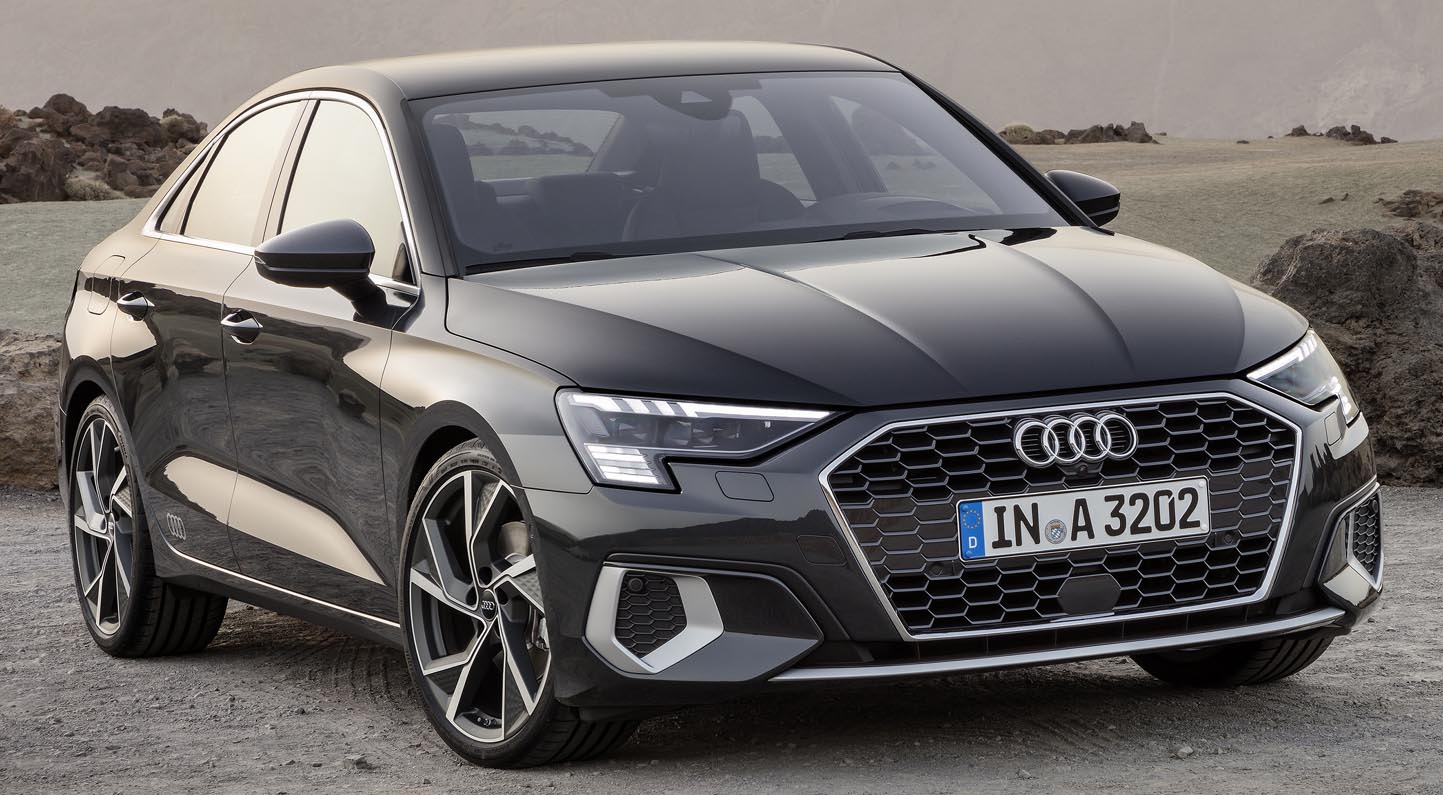
Balanced: the 1.0 TFSI three-cylinder
The entry-level engine is the 1.0 TFSI, a turbo three-cylinder with a six-speed manual transmission . The engine produces 81 kW (110 hp) and delivers the maximum torque of 200 Nm (147.5 lb-ft) between 2,000 and 3,000 rpm. The compact three-cylinder engine weighs just 88 kilograms (194.0 lb) and its crank assembly is so finely balanced that it runs in a quiet and smooth manner even without a balance shaft. The exhaust manifold is an important element of thermal management and is integrated in the cylinder head.
Just like the crankcase, it has its own cooling circuit. The modified Miller combustion process is a further efficiency technology. It offers advantages in the partial-load range in particular, i.e. the range in which the engine operates most frequently.
Highly efficient: the 1.5 TFSI with cylinder deactivation
The four-cylinder gasoline engine develops 110 kW (150 hp) and delivers 250 Nm (184.4 lb-ft) of torque between 1,500 and 3,500 rpm. The highlight with the 1.5 TFSI is the cylinder on demand (COD) system. At low and medium loads, it temporarily deactivates the second and third cylinders. The engine is very light thanks to its aluminum crankcase. The cylinder linings have an iron coating that reduces friction significantly. The cooling module allows efficient thermal management, assisted by the exhaust manifold integrated in the cylinder head.
The 1.5 TFSI with a mild hybrid system has the same output as its sister engine . Even the driving performance is identical – although this one operates even more efficiently.
Powerful: the mild hybrid system
The mild hybrid system for the 1.5 TFSI is built up as follows: A belt alternator starter (BAS) is installed on the combustion engine. It feeds a 48-volt electrical system that integrates a compact lithium-ion battery under the front passenger seat. A voltage converter connects the conventional 12-volt electrical system. In customer operation, the MHEV system achieves a fuel-consumption advantage of up to 0.4 liters (0.1 US gal) per 100 kilometers (62.1 mi). When the driver takes his foot off the accelerator or applies the brake slightly, the BAS can electrically recuperate up to 12 kW of power and feed it to the battery. When driving off and accelerating from a low rotational speed, it assists the TFSI with up to 9 kW and an additional 50 Nm (36.9 lb-ft) of torque. In certain driving situations, it shifts the loads such that the engine operates more efficiently in an area of the characteristic map with greater efficiency. It also ensures that the 48-volt battery is charged. This stores enough power to enable the car to coast with the engine switched off in many situations. The BAS then quickly and conveniently restarts the TFSI, like at the end of the start/stop phase, which already starts at a residual speed of 22 km/h (13.7 mph).
Optimized: the TDI engines
In terms of diesel engines, the 2.0 TDI is available in two versions. The smaller diesel engine produces 85 kW (116 hp) and delivers a hefty 300 Nm (221.3 lb-ft) of torque between 1,600 and 2,500 rpm.
In the top version of the 2.0 TDI, 110 kW (150 hp) and the A3 30 TDI, this is done by a completely new six-speed manual transmission. It covers the torque range from 200 to 340 Nm (147.5-250.8 lb-ft) and works very efficiently, saving up to 5 grams of CO2 per 100 kilometers (62.1 mi) compared with the predecessor transmission. The first gear usually has a very short ratio in order to enable a powerful start-off, whereas the highest gear has a very long ratio for the purpose of lowering the rotational speed and consumption.
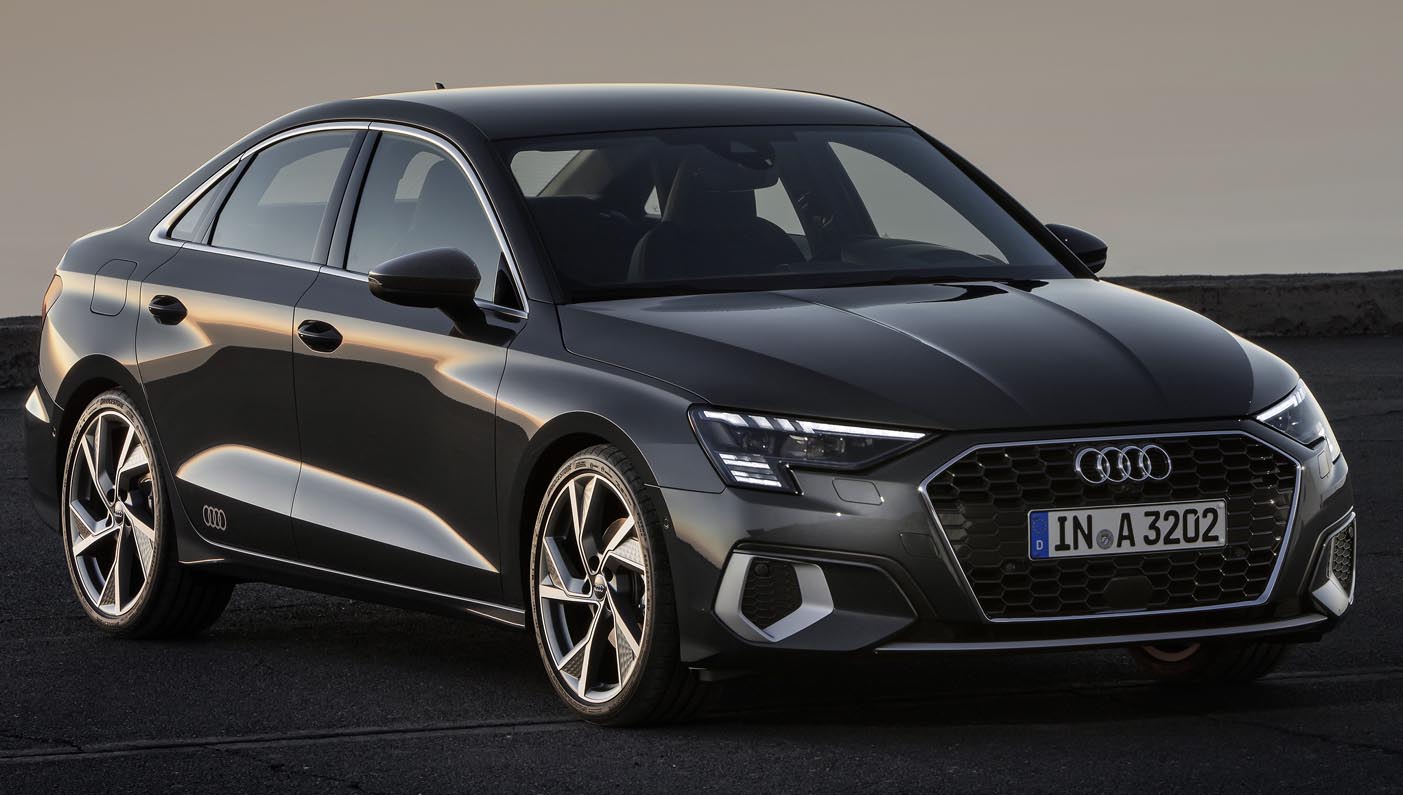
Custom-made: the seven-speed S tronic
The MHEV engine variant and the A3 35 TDI are equipped with a seven-speed S tronic in different versions, which the driver can control via paddles on the steering wheel. Its gear ratio is also relatively short in the lower gears and long in the higher gears. In interaction with the optional dynamic handling system Audi drive select, the quick-shifting dual-clutch transmission offers a freewheeling function that is activated in many situations when the driver takes his foot off the accelerator.
The technology of the two transmissions differs in important aspects. In the case of the seven-speed S tronic for the gasoline engine, the two clutches require no oil supply, which increases their efficiency. In the case of the transmission for the 2.0 TDI, they are cooled with oil as needed.
Suspension
Agile in town, sporty on country roads, comfortable on the highway – Audi further developed the strengths of the predecessor model in the suspension of the new A3. Even the standard suspension is sporty and balanced, combining pleasant ride comfort with good dynamics. The front and rear track widths have each increased by 11 millimeters (0.4 in), to 1,554 (61.2 in) and 1,525 millimeters (60.0 in) respectively.
With regard to the axle concept, Audi relies on a MacPherson axle with bottom wishbones at the front. Models with an output from 110 kW (150 hp) are equipped with a four-link rear suspension with separate spring/damper arrangement. In the other engine variants, a light and compact torsion-beam rear axle is used. The swivel bearings are made of aluminum.
Even the standard electromechanical steering with speed-dependent power assistance has a sporty and direct gear ratio. The following applies to the optional progressive steering: The further the driver turns in the wheel, the more direct the ratio becomes. This reduces steering effort in urban traffic and when maneuvering; in tight curves, the new A3 is even more agile and precise.
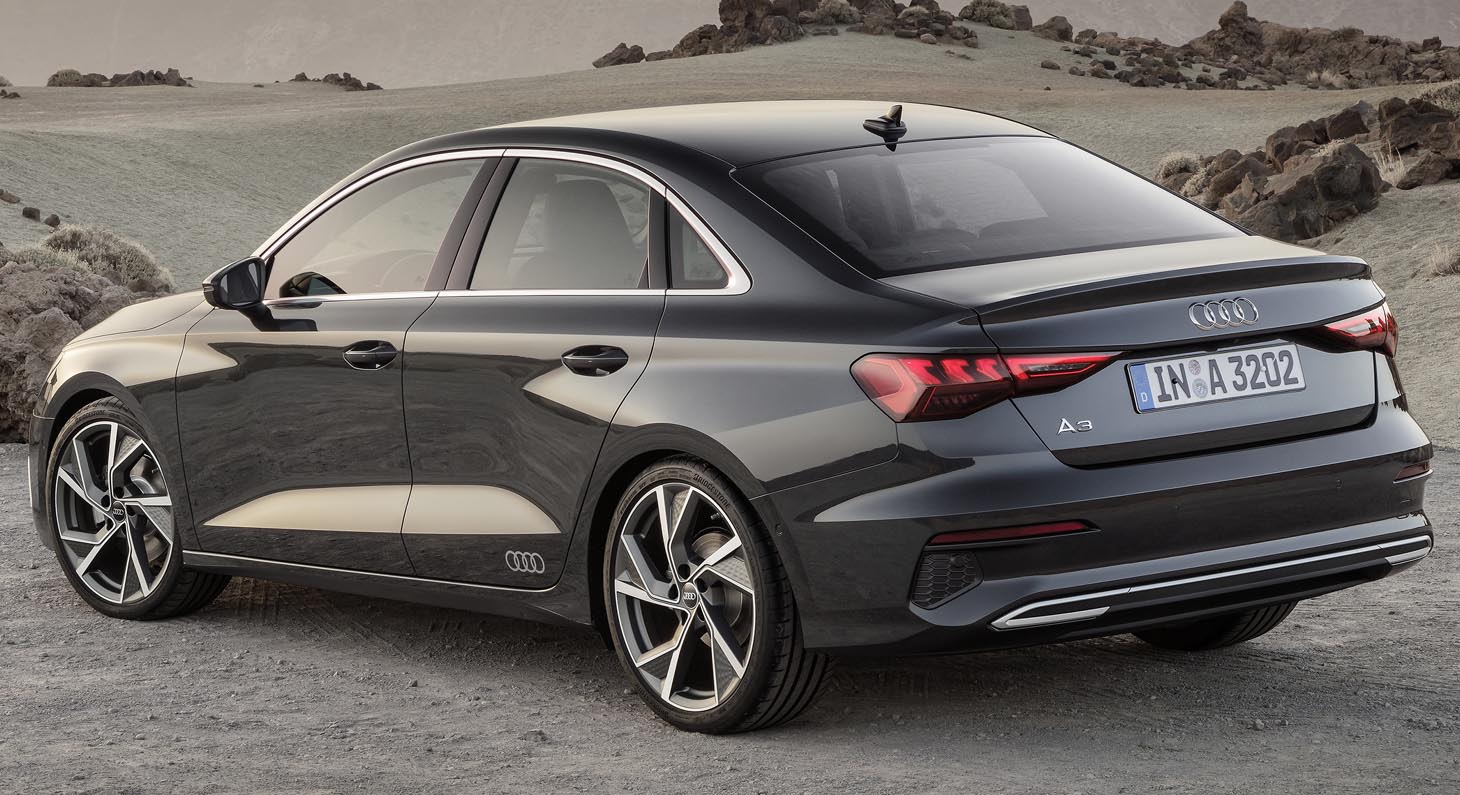
Lowered: two optional suspensions
For the engine variants with an output from 110 kW (150 hp), the suspension is available with adaptive damper control upon request, which lowers the body by 10 millimeters (0.4 in). Sensors measure the vertical acceleration of the body and the relative movement of the individual wheels. The control unit processes their signals within milliseconds. Through valves that regulate the flow of oil, it adapts each damper individually to the road condition, the driving situation, and the setting in the Audi drive select dynamic handling system. Here, the driver can select between dynamic or comfort-oriented basic tuning in the profiles auto, comfort, and dynamic. The suspension with adaptive damper control enables a very wide spread between comfortable roll motion and agile handling. With the sport suspension, which comes as standard with the S line exterior, the focus is clearly on dynamics. Due to the tauter tuning of the suspension and dampers and the fact that the body height is lowered by 15 millimeters (0.6 in), the A3 conveys an even more direct contact with the road surface.
Controlled: Audi drive select and ESC
The driving experience becomes even more varied with the optional Audi drive select system. The driver can use this system to vary not only the dampers, but also the characteristics of the steering assist system and throttle response, as well as the shift points of the S tronic – for the engine variants with 110 kW / 150 hp. In this case, he can select from the profiles auto, comfort, dynamic, efficiency, and individual.
As part of the sensitive and safe regulation of the Electronic Stabilization Control (ESC), the wheel-selective torque control also contributes to dynamic handling: Should the front wheel on the inside of the curve lose grip when cornering at high speed, it is braked slightly to ensure that the car maintains a stable and sporty course.
Centralized: the modular dynamic handling control
New in the A3 is the modular dynamic handling control. The central system collects the data from all components relevant for transverse dynamics and thus ensures that the interplay between them is precise and quick. It computes the optimal settings for the adaptive dampers, the ESC and the quattro drive – predictively based on steering movements. The modular dynamic handling control increases agility in this way, especially on winding roads.
Enlarged: wheels and brakes
The wheel portfolio of the new A3 models ranges from 16 to 19 inches and up to a tire dimension of 235/35. The two exterior lines include 17-inch wheels, while offerings from Audi Sport are available for 18-inch and 19-inch wheels. The tires for all dimensions were optimized in terms of rolling resistance without compromising handling or braking performance.
The brake disks on the front axle are internally ventilated and measure 312 millimeters (12.3 in), while those on the rear axle have a diameter of 272 millimeters (10.7 in). The brake pistons are actuated by an electric brake booster. Due to its very quick response time, the developers were able to increase the air gap between the brake pad and the brake disk slightly. This solution eliminates friction loss due to slight contact with the brake pads and increases efficiency.
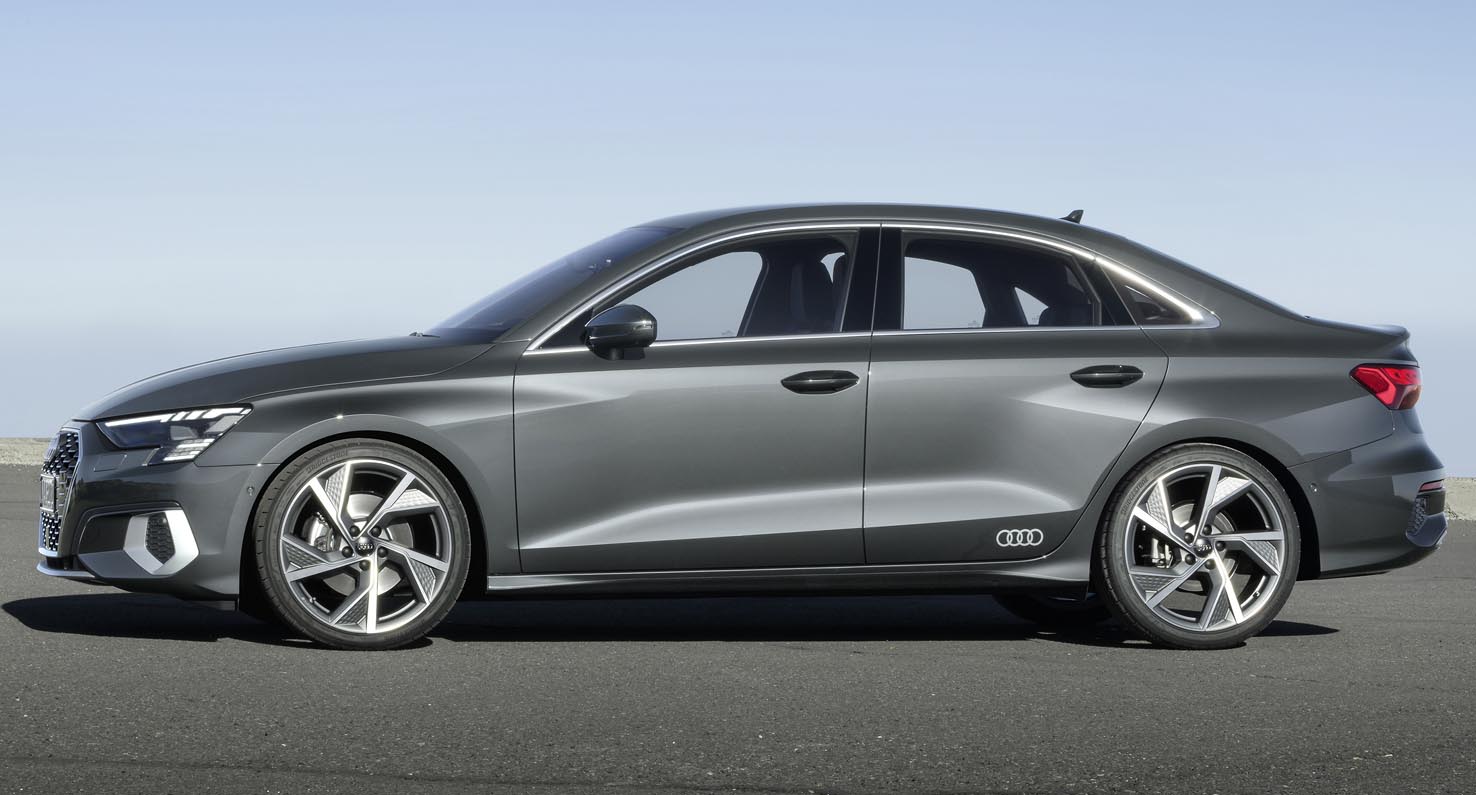
Driver Assist Systems
There is a lot of technology expertise in the new Audi A3. This is made particularly apparent by the extensive set of driver assist systems, many of which are from the full-size class. The fully equipped version of the premium compact car has a front radar that can scan up to 160 meters (524.9 ft) ahead, two rear radar sensors, each with a range of 70 meters (229.7 ft), a front camera, twelve ultrasonic sensors, and four surround view cameras.
Safeguarded: three standard systems
In the standard Audi pre sense front system, the camera works with the front radar. This allows the new A3 to avoid accidents with other vehicles, pedestrians, and cyclists in front of the car, or at least to reduce the severity of such accidents. The system outputs an optical, acoustic, and haptic warning to the driver. In an emergency, it initiates emergency braking. The collision avoidance assist is another standard safety system. It broadens the spectrum of Audi pre sense front and helps the driver to steer around an obstacle. The standard lane departure warning also performs steering corrections to ensure that the car does not depart from its lane inadvertently.
Well versed: the adaptive cruise assist
The adaptive cruise assist (ACA) is a highlight among the driver assist systems. It is the most complex system for the new A3 and performs the tasks of steering, accelerating, and braking for the driver to a great extent on many sections of the journey up to a speed of 210 km/h (130.5 mph). The ACA includes a capacitive steering wheel. Advantage: The driver does not have to apply any steering torque, but just touch the steering wheel gently in order to maintain automatic lateral guidance. The system is available both individually and as part of what is known as the assist package with MMI navigation plus for all models, including those with manual transmission.
The package also includes efficiency assist. It indicates to the driver via the display when it should take its foot off the accelerator, for example because it is approaching a corner or built-up area. The system obtains the information from the navigation map. If the ACA is active, it can also detect vehicles driving in front via the front sensors and adapt the vehicle’s speed to theirs.
The high-beam assist and the emergency assist are also part of the extensive assist package. It also includes two parking functions: the park assist and the parking system plus. The former can guide the vehicle into kerbside and bay parking spaces almost independently, using ultrasonic sensors all around the car. The driver only has to accelerate, brake and shift gears. In the case of kerbside parking spaces, the system provides the same assistance when maneuvering out of the parking space. It can also be activated during an ongoing manual parking procedure, for example if the driver realizes that it approached the parking space from an awkward angle.
Optional: further systems
The lane change warning, the exit warning, and the cross traffic assist rear are also useful in urban traffic. They use the signals output by the rear radar sensors to alert the driver to vehicles approaching from the rear or the side. Surround view cameras will follow as an individual option in the course of the year. They display the immediate surroundings of the A3 on the MMI screen, and the driver can choose from different views that make parking and maneuvering easier.
Equipment Lines
There are three exterior lines and interior lines available for the new A3 that can be combined as desired. In addition to the basic version, there is the advanced exterior and the S line exterior. With regard to the colors and materials in the interior, A3 customers can choose between basic, design selection, and S line. Thus both models offer numerous possibilities for individualization.
The A3 models feature a generous list of standard equipment. The exterior includes 16-inch aluminum wheels and headlights with LED technology. The interior comes with a multifunction steering wheel, a digital instrument cluster, and a 10.1-inch touch display as standard. The standard scope of assist systems includes Audi pre sense front, the lane departure warning, and the collision avoidance assist. Optional comfort features include the seat massage in the lumbar area, the panoramic glass sunroof, 3-zone automatic air conditioning, the ambient lighting package plus with its various settings (standard with the interior design selection), and the adaptive cruise assist.
Tapered: the exterior variants
In the advanced exterior variant, the frames of the air inlets are designed in selenite silver, while those of the S line exterior are a matt platinum gray. There are similar differences at the rear end. The Singleframe of both lines is painted in titanium black and surrounded by a chrome frame.
The air inlets and the blade that completes the front end at the bottom are larger and more striking with the S line exterior. There is a third flat air inlet above the blade. The honeycomb grilles in the Singleframe are larger and have small insert strips. The grille is mounted a little lower and there are three flat louvers above it. The roof edge spoiler of the A3 Sportback has a dynamic contour and the diffuser – complete with honeycomb grille – has a more dominant design. For the Sedan, a spoiler on the luggage compartment lid comes as standard with both lines.
In both lines, the optional black styling package further sharpens its appearance. It comprises the frame of the Singleframe and the air inlets as well as the blade. In the S line exterior, it also includes the frame of the diffuser and the insert strips in the side sill. The housings of the exterior mirrors are also available in black. Roof rails in matt black or anodized aluminum are available as an option for all three exterior variants of the A3 Sportback. A3 customers can choose between twelve colors for the paint finish. Atoll blue, turbo blue, Manhattan gray, and python yellow are new colors.
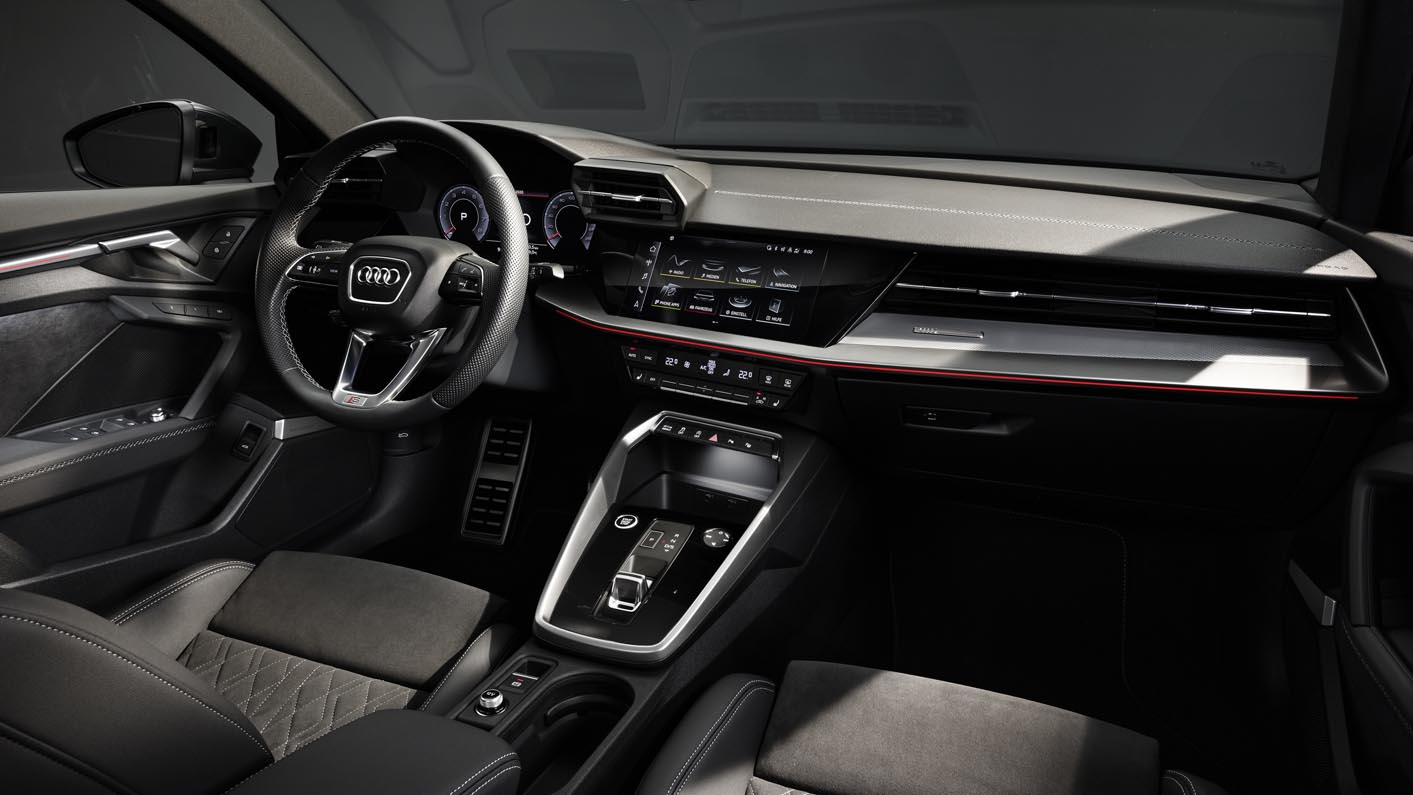
Individualized: the interior lines
Different seat upholstery in various color combinations, ranging from sustainable recycled material to fine Nappa leather, are available for the three interior designs. The “Puls” and “Torsion” materials used to cover the seats in the S line and design selection interior variants consist of up to 89 percent recycled polyester. For one set of seats made of “Torsion” material, 45 1.5-liter PET bottles are shredded, melted down, chopped, and extruded to create fibers that are then spun into threads. There is also an attractive range of colors and materials for the decor surfaces on the instrument panel, for example insert strips made of gray birch wood, aluminum, or carbon.
Both lines include a three-spoke multifunction steering wheel, illuminated door sill trims, and stylish contrasting stitching on the center armrest, the door armrests, and the instrument panel. The ambient lighting package plus, which can be set to any one of 30 colors, illuminates the distinctive design lines with striking light and the surfaces with soft light. The interior S line includes sport seats with leather and Alcantara covers, which are decorated with a new rhombus pattern. A black headlining, stainless steel pedals, S embossing in the front seat backrests, and a steering wheel with contrasting stitching and the S emblem round out the interior S line.
